The Beagle is a sturdy and small hound mostly known for their tricolor saddle markings or bicolor tan & white coat. Let’s learn about all the different Beagle coat colors.
Standard Beagle Coat Colors
What colors do Beagles come in?
Let’s have a closer look at the different Beagle colors and patterns:
Black Tricolor Beagle






About all Beagles are fixed for patterned coat (ky/ky).
And the most common of Beagle markings is black-based saddle tricolor.
Genetically, the term “tri-color Beagle” refers to a dog with three “colors”: A saddle pattern (asa/asa) on tan or red base pigment with white piebald spotting (sP/sP).
Most Beagles express black eumelanin (B/- D/-) making their saddle black.
Typically, the black saddle is more or less restricted to the back of the dog on homozygous dogs (asa/asa).But black saddles can vary a little in size or fade over time.
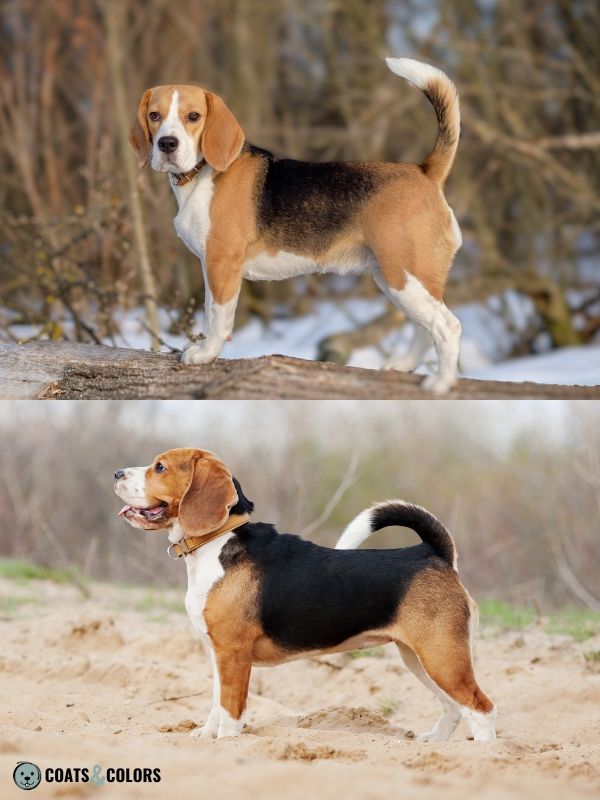
And some dogs keep some black hairs on their ears and others don’t.
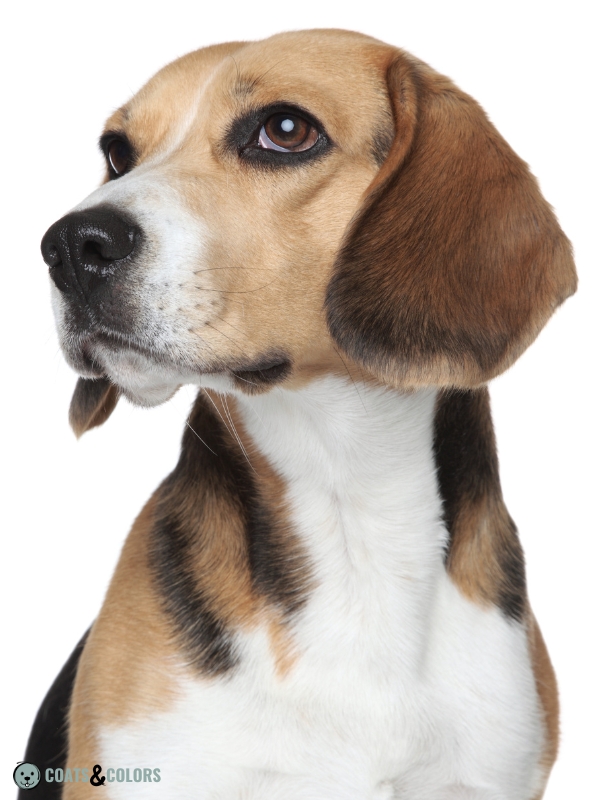



Some Beagles (probably those carrying tan points asa/at) end up with a rather dark creeping tan phenotype causing larger black markings than expected.
These dogs keep more of their black pigment and often end up with black that extends beyond a normal saddle pattern, e.g. a black on their neck, ears, tail, and a widow’s peak on their forehead.
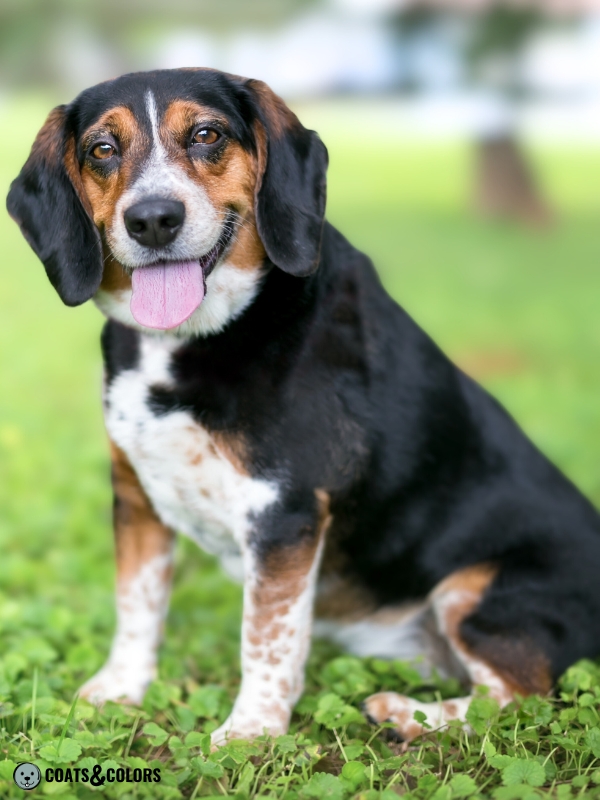
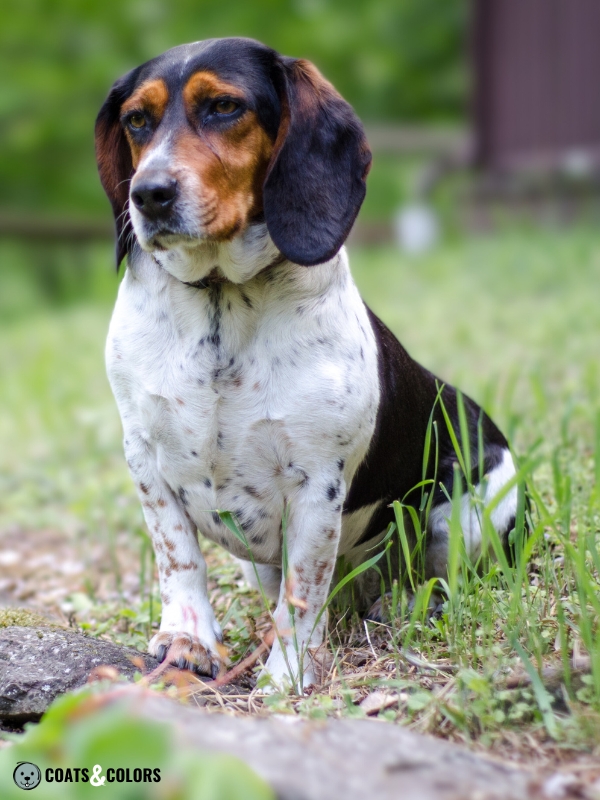

Depending on the intensity of the phaeomelanin pigment, the yellow pigment on a tri Beagle might be more or less rich in color. There are black, tan and white as well as black, red and white Beagles.
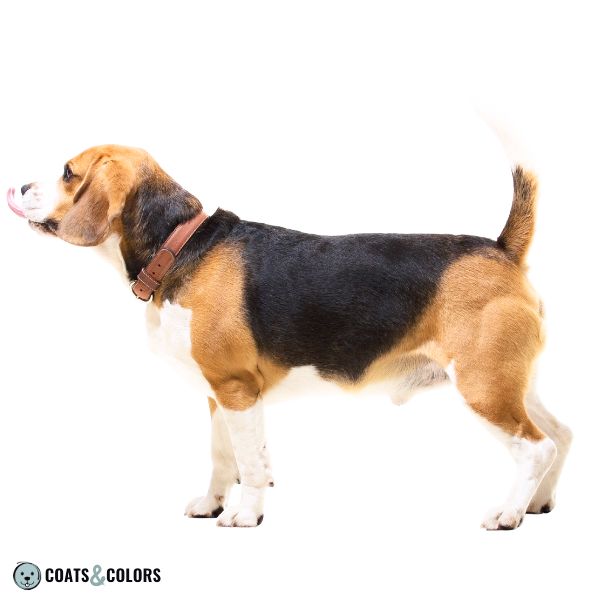
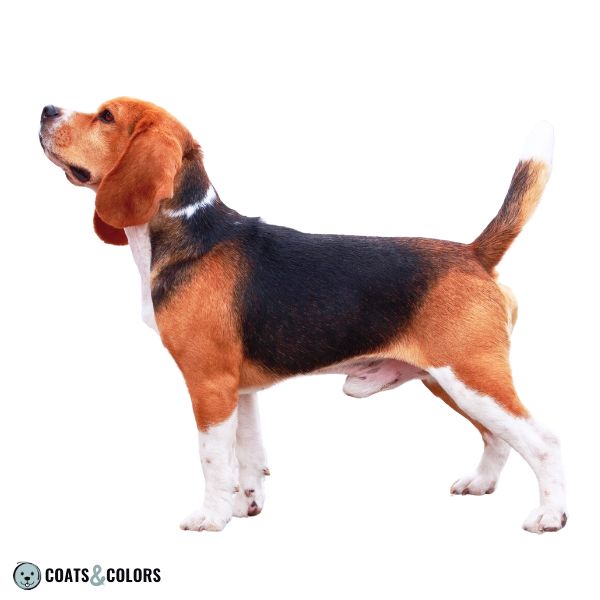
If the base pigment gets even lighter it is called black, fawn & white.
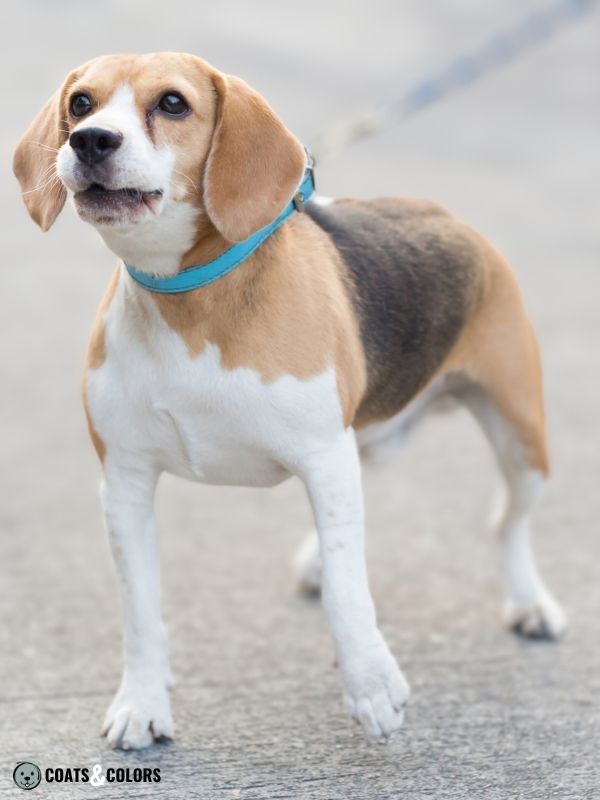

Lastly, the “third color” on a tricolor Beagle is white.
Most Beagles are homozygous for piebald spotting (sP/sP). The extent of their white markings is often moderate but can be larger on individual dogs[7].
A piebald pattern that cuts into the saddle portion of the coat is called “open-patterned“.
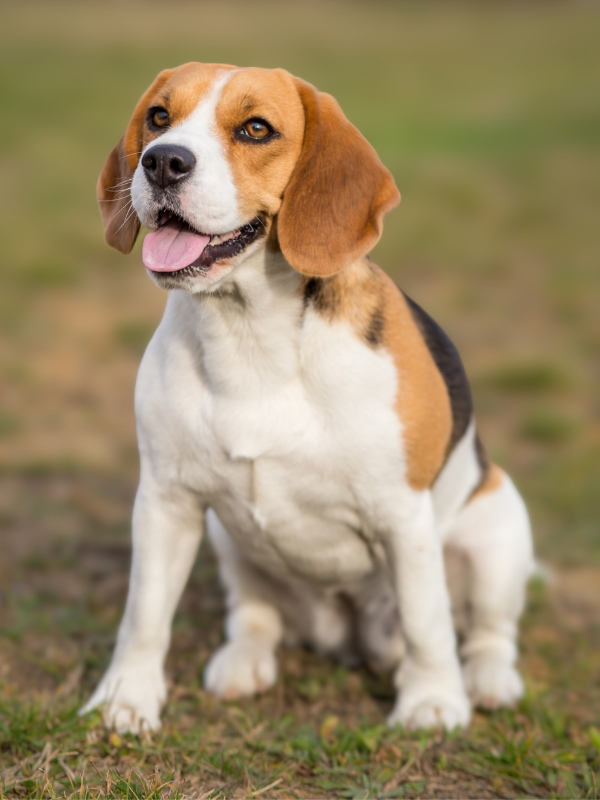

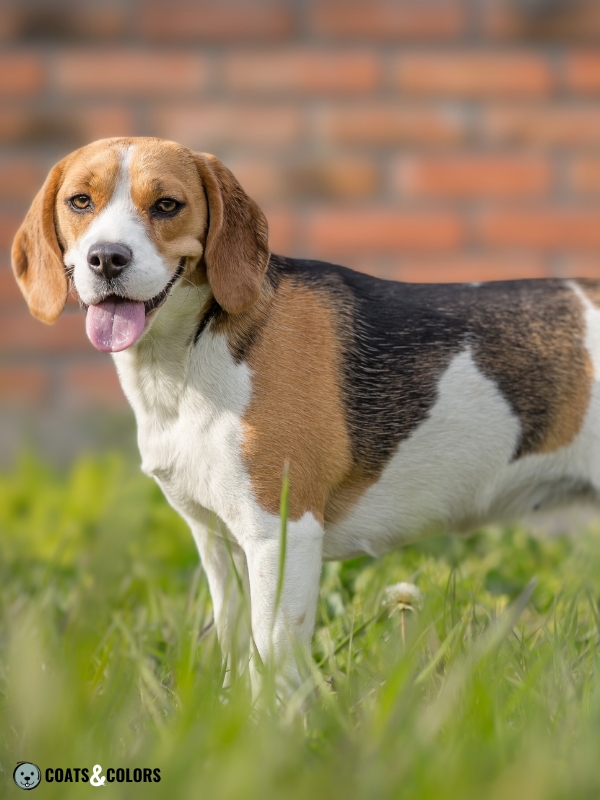



Some tricolor Beagles have a jet-black saddle with crisp edges.
But saddle patterns are notorious for fading a little over time. Dogs often develop lots of tan hairs inside and along the edges of their black saddle, sometimes called “faded tricolor“.


The AKC tries to account for the different ratios of black, yellow, and white in tri-color Beagles by the order in which pigment names appear in their color terms.
The most noticeable color on a black, tan and white Beagle should be the (1) black saddle, followed by (2) tan markings and finally (3) some white.
On a black, white and tan you can expect larger white markings that cover more of the yellow pigment. And if the white markings get too large a dog will be called white, black and tan.
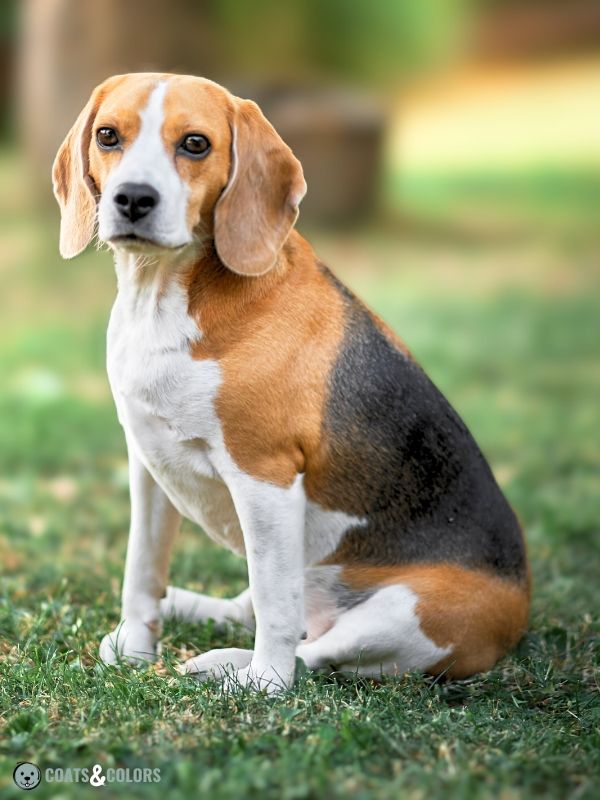


Beagle Color Change
Beagle puppy colors may change when a dog grows into its adult coat.
Beagle puppies that will end up with a saddle pattern (asa/asa) are born with normal black and tan markings. They can be almost black at birth with some faint hints of tan on their legs and bum.
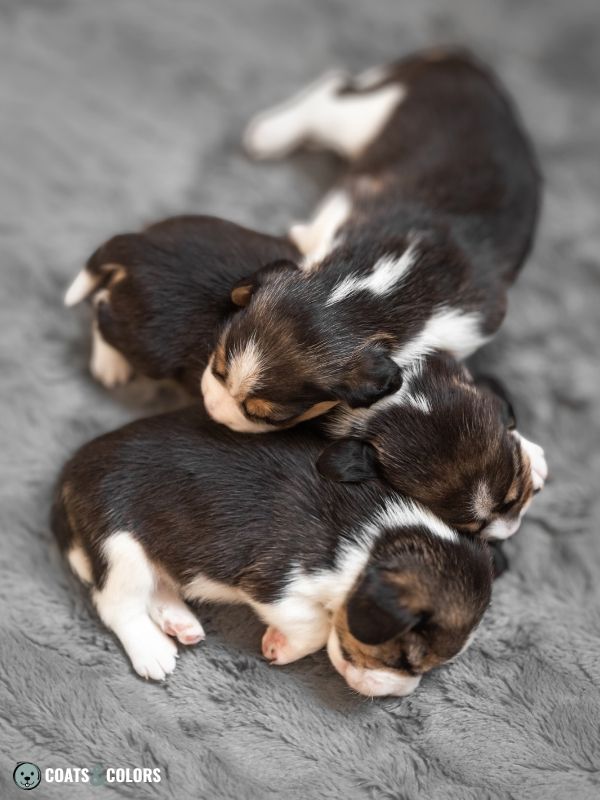
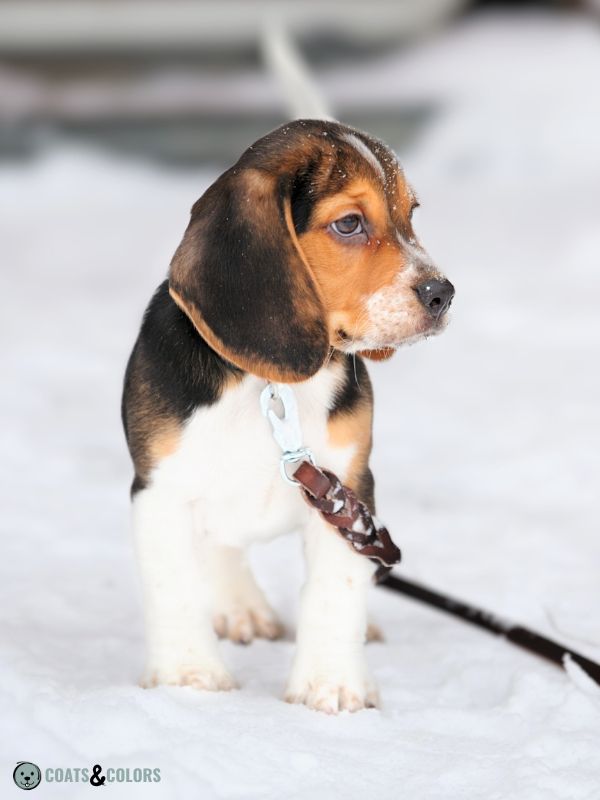

But their tan markings soon begin to grow and push back the black until only a black saddle on their back remains.
Some puppies change their color faster than others.
While tan hairs grow into the black areas it is quite normal to transitionally find lots of black shading, black ear lacing or even a grizzled widows peak on a puppies forehead.
Blue Tricolor Beagle
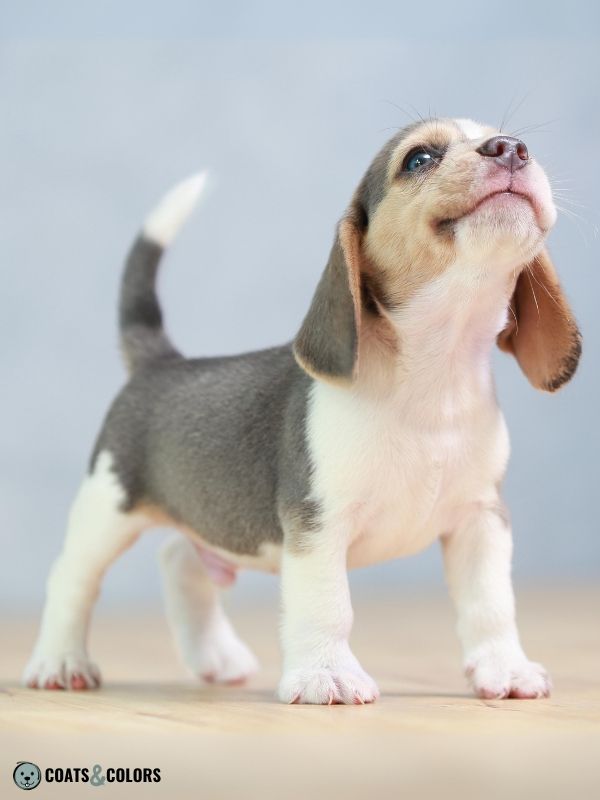

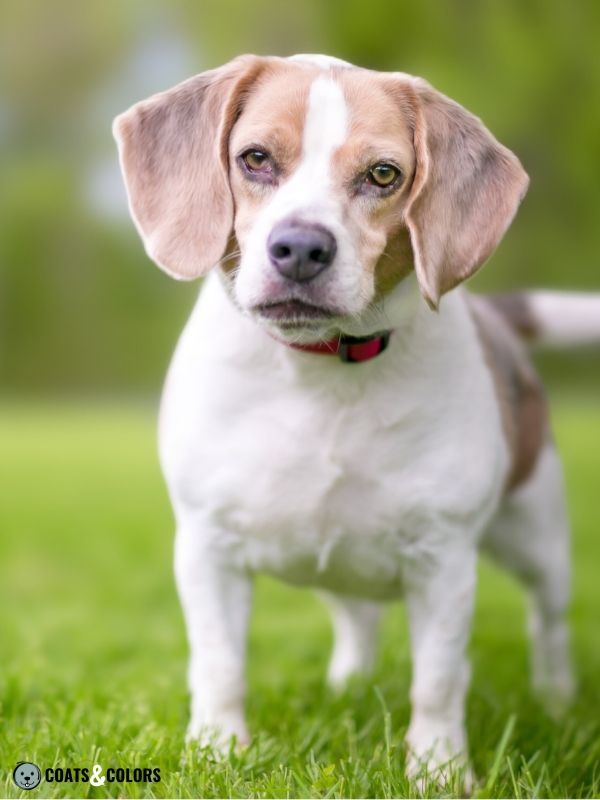
The only difference between a black and a blue tri Beagle is the color of its eumelanin. Technically, a blue, gray or silver beagle is a black Beagle but with diluted pigment.
When grains of black pigment clump together (that’s basically what happens) we perceive them as blue, slate or gray. This happens when a dog is homozygous for color dilution (d/d).
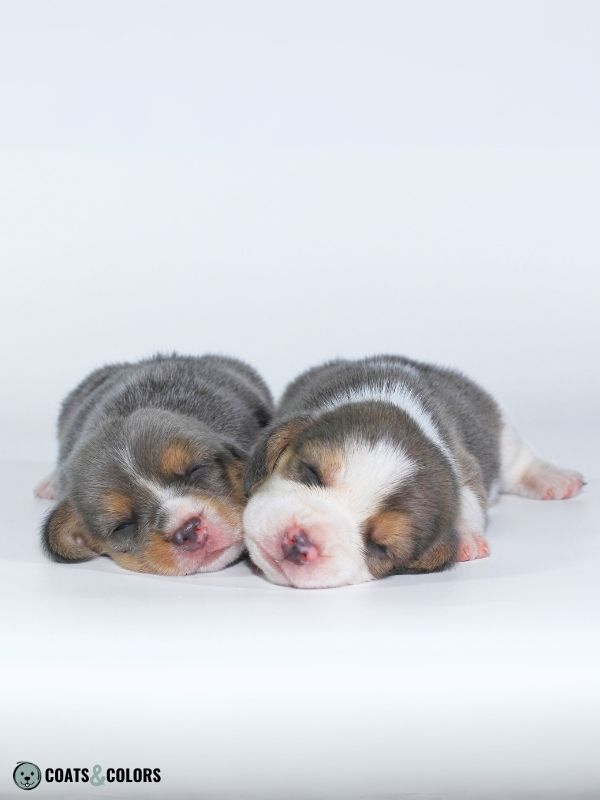
On blue tri Beagles, all the eumelanin is blue. This includes not only the dark saddle but also the nose pigment, skin pigment, paw pads, nails, lips and eye rims.
Blue Beagles also tend to have lighter eyes with a more greenish to yellowish shade.
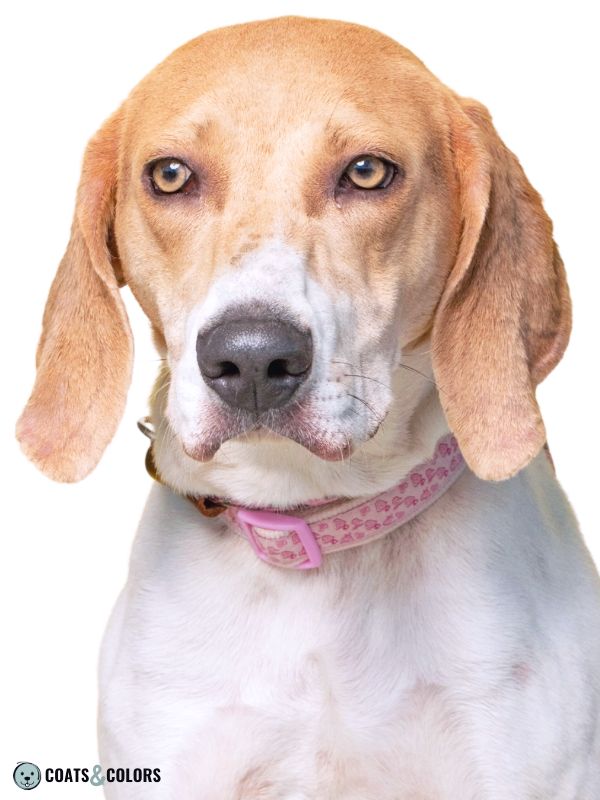
Since the FCI and Kennel Club standards only allow black noses and dark eyes, you basically can’t enter conformation events with a diluted black or silver Beagle under FCI or KC rules.
Still, the FCI and KC standards list “blue, white and tan” as permissible color. This is because they call any black dog with a black nose, dark eyes and black ticking “blue” (what the AKC calls bluetick).
While ticking adds spots to white markings, real diluted black is already present at birth and lightens any black area to blue.
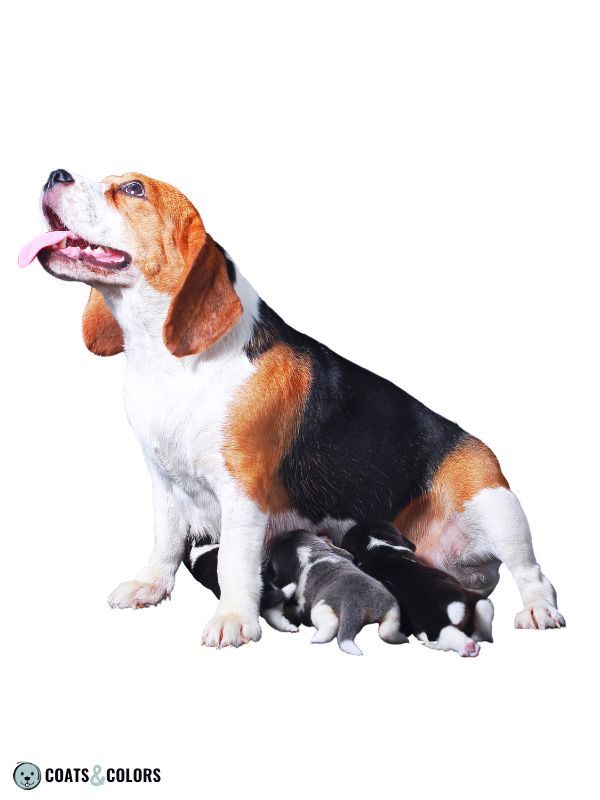
Chocolate Tricolor Beagle
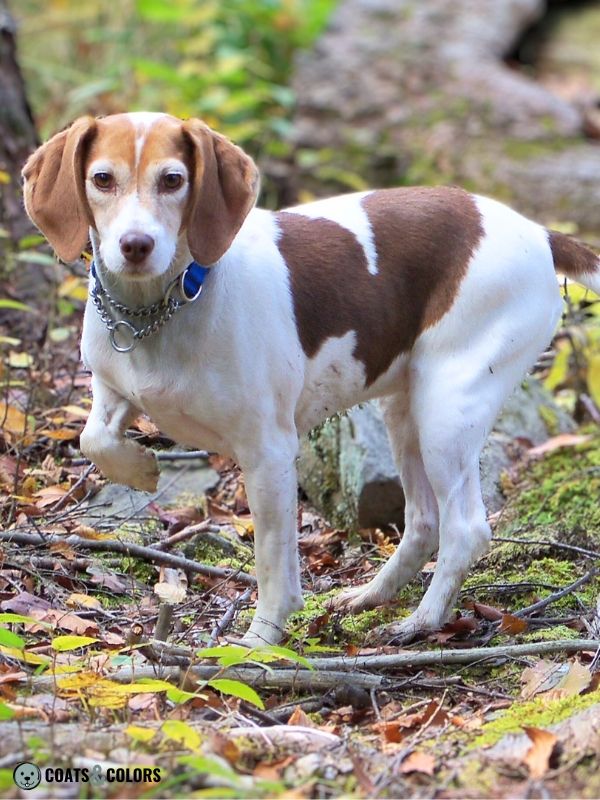


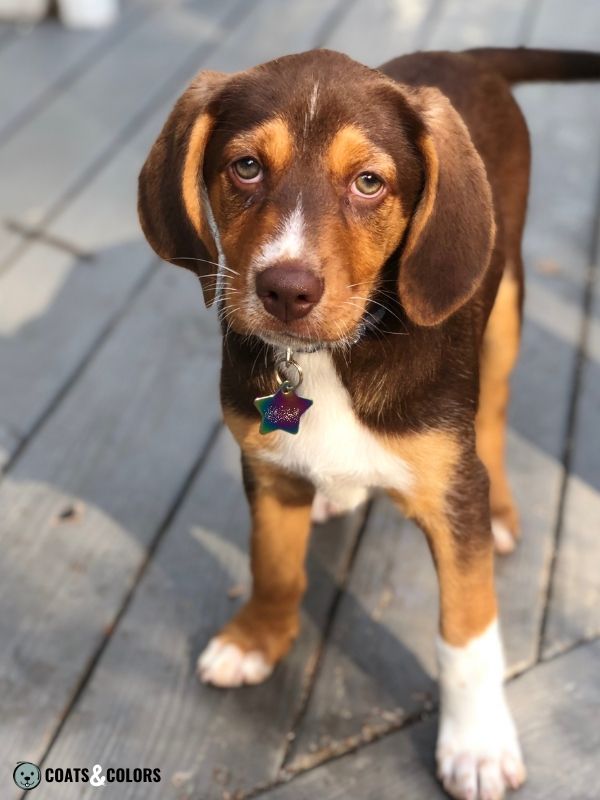

Brown, white & tan Beagles display a (very pretty, dare I say so) variation of saddle tri. They have normal white and tan markings but with a rich brown saddle pigment on their back.
Chocolate tri Beagles can’t express black pigment.
Instead, a brown Beagle expresses eumelanin with a dark chocolate or liver color.
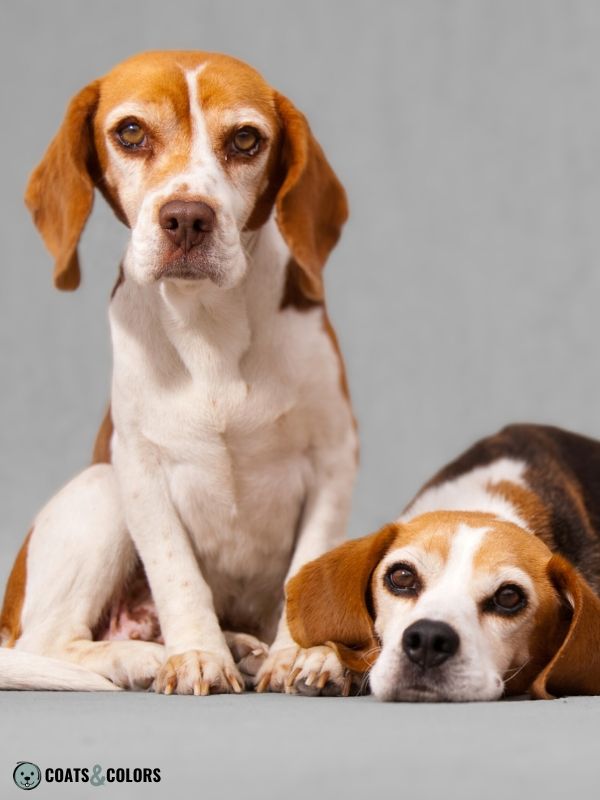
Look at the nose pigment.
Brown Beagles are homozygous for a recessive mutation (b/b) which turns all the eumelamin on a dog brown.
This, chocolate Beagles also have a liver-brown nose, brown lips, eye rims, skin and nail pigment. And their eye colors often fall into the yellow to honey-colored spectrum.
Again, the liver color on a chocolate tricolor Beagle is not allowed by the official FCI or KC standards because of the light eyes and brown nose that go with this coat color.
Lilac Tricolor Beagle

With brown pigment (b/b) and color dilution (d/d) present in a Beagles gene pool, some dogs end up with diluted brown pigment (b/b d/d).
This lighter shade of eumelanin is often called lilac, lavender or isabella.
If this happens you end up with a light brown Beagle that also has a lilac nose and lilac pigment in his skin, nails, lips and eye rims. The eye color on lilac Beagles tends to be very pale and yellowish.
Lilac Beagles are somewhat rare if not bred on purpose.
The AKC doesn’t even use a specific term to refer to this color although they don’t exclude this color. But again, the FCI neither wants brown nor dilution and the least of all both on the same dog!
Black & Tan Beagle
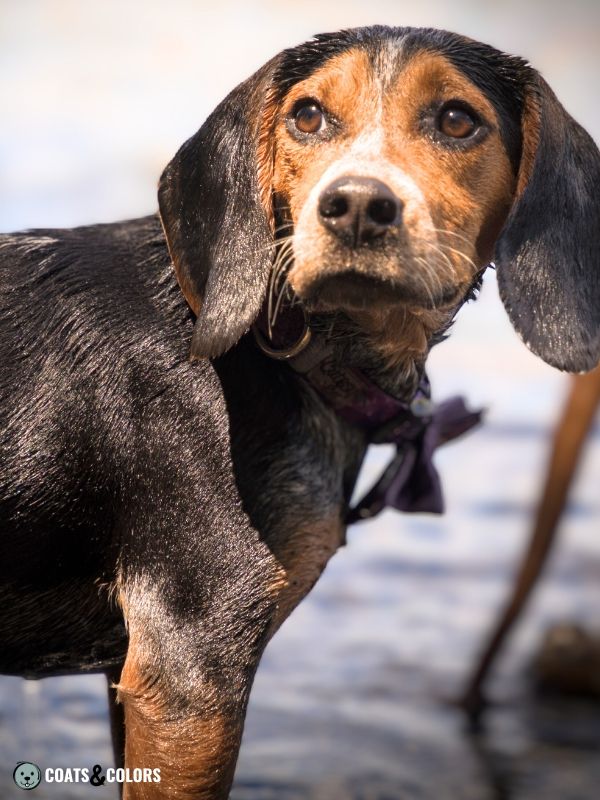
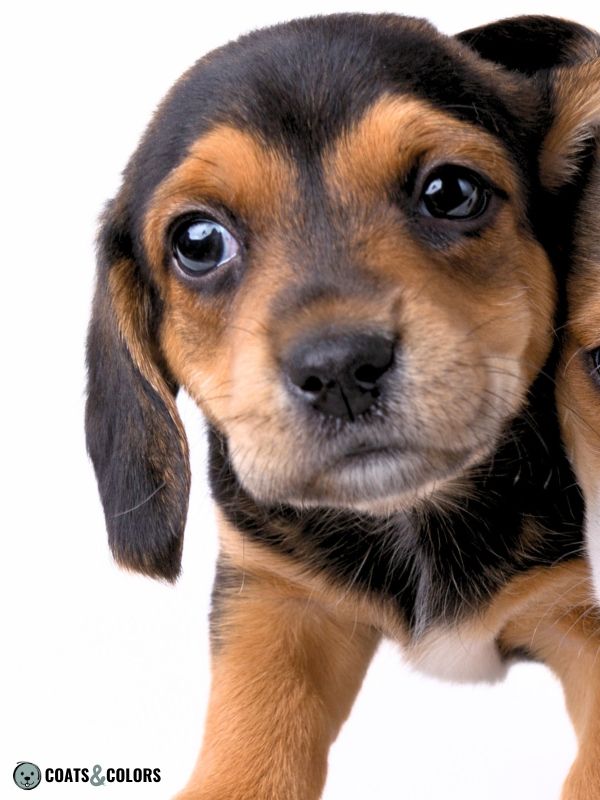
The AKC lists black & tan as a standard color while red & black is not.
But they don’t provide any information what exactly they mean by black & tan when they talk about Beagle colors specifically. And I haven’t found a real definition where they draw the line between black-and-tan and red-and-black. So we have to guess until someone chimes in.
Minimal white patterns can be found in some lines of Beagles that sometimes produce dogs that have one copy of piebald (S/sP). And with the S allele being around, some of these dogs might even end up without any white spotting at all if they get two copies of non-piebald (S/S).
Interestingly, the AKC lists black & tan as a standard color but not red & black.
And I have no clue how to interpret this. Maybe US Beagles without white should also not be saddle-patterned but have to have a real black-and-tan pattern? If you know, please enlighten me!
I guess a black and tan Beagle is a patterned dog with a black-based tan point pattern (at/at) or creeping tan (asa/at) with black as the major color and no or minimal white (S/S or maybe even S/sP).
But on saddle patterned dogs the red parts would cover most of the dog. So red & black might refer to a black-based saddle pattern (asa/asa) with no to little white.
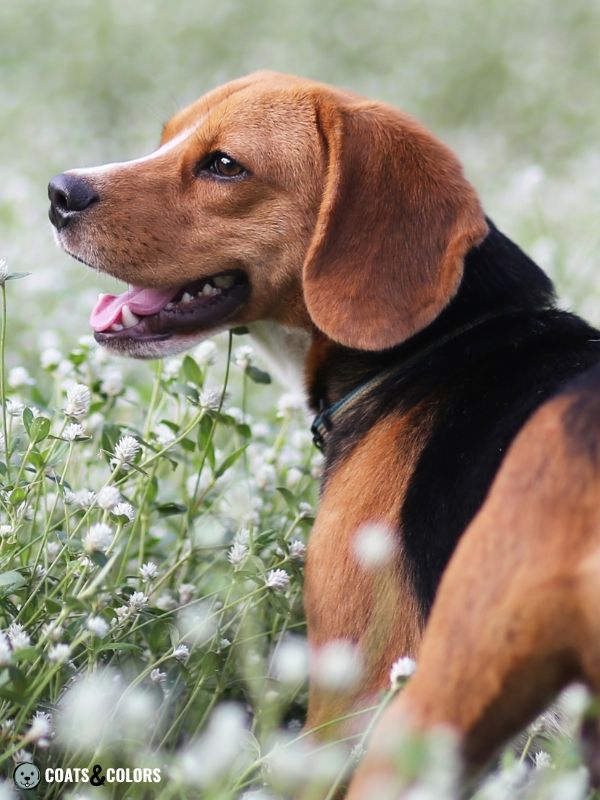

Saddle-patterned dogs and tan-pointed dogs are both born black with small tan markings.
And given the high chance for a Beagle to end up with at least one asa allele, a black and tan Beagle puppy is likely to fade into a saddle pattern or creeping tan pattern depending on his A-locus.
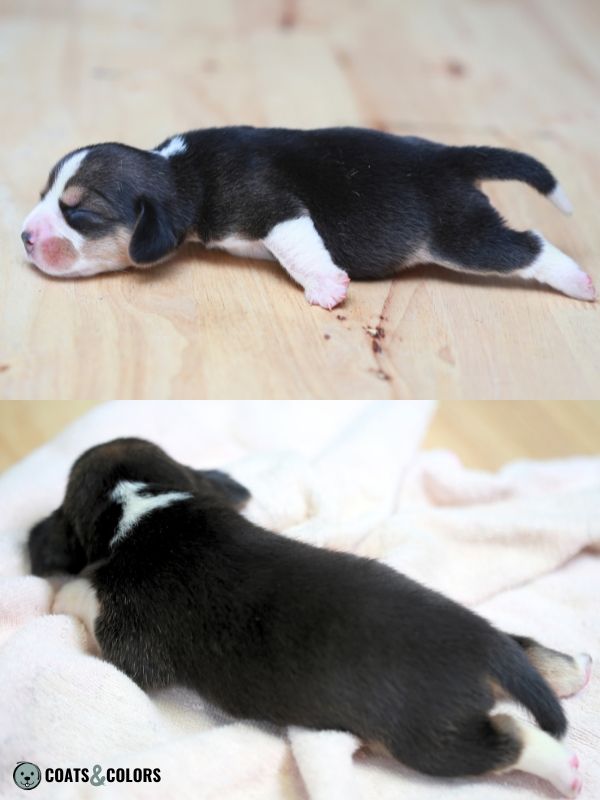
Sometimes these pattern are wrongly called black and brown.
But it’s better to refer to the yellow portions of coat as “tan” or “red” and reserve “brown” for actual liver or chocolate colors (which a black dog never has since he is either black B/- or brown b/b).
Black & White Beagle
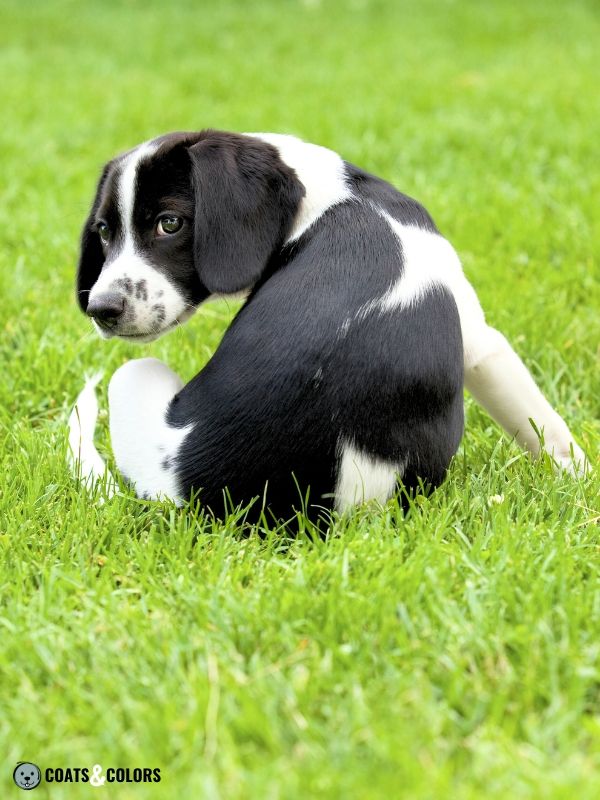
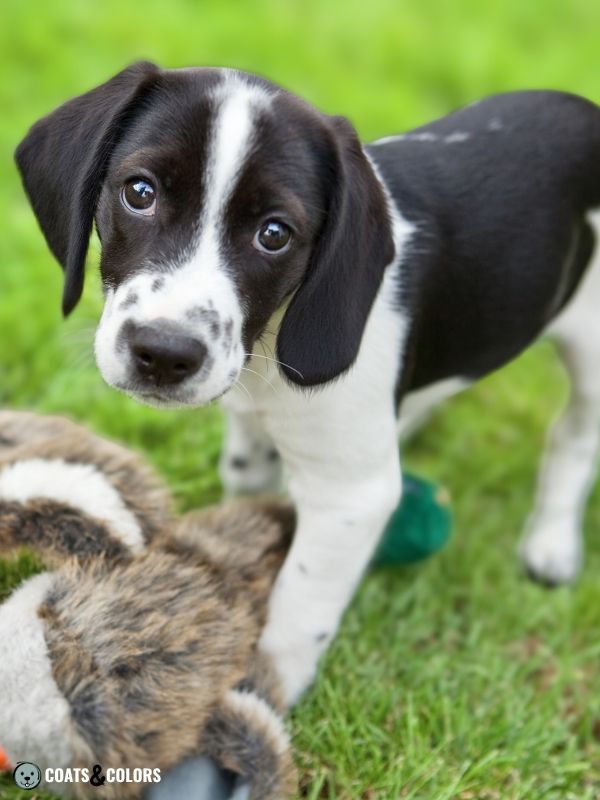
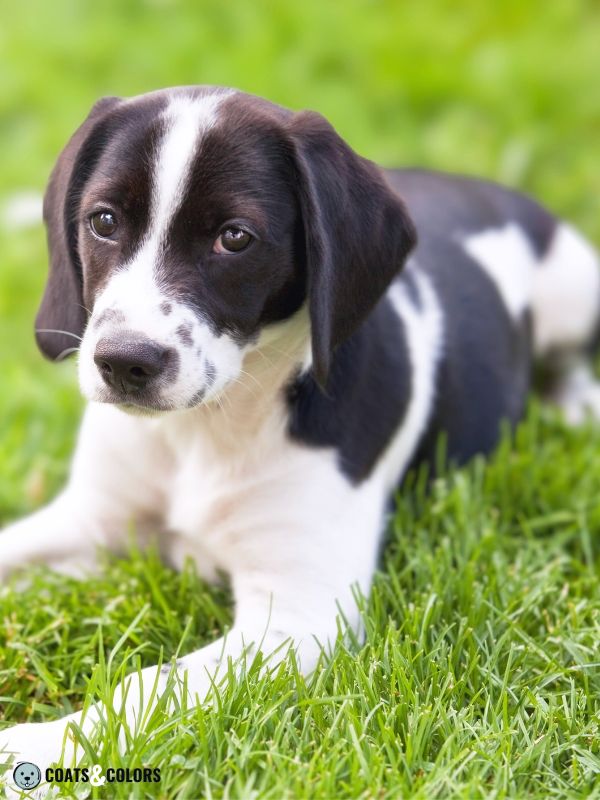
The FCI and KC breed standards for the Beagle both list black & white as one of the official Beagle colors. But the AKC does not, for whatever reasons.
They seem to talk about solid black dogs with white markings and no tan.
Black and white Beagles are quite rare.
According to Laboklin, there is no dominant black in Beagles[6].
And the only other explanation for their pattern is recessive black.
These dogs are patterned (ky/ky) but with two faulty versions (a/a) of the signal that should tell pigment cells to switch to tan pigment. So they end up with a black coat.
Brown & White Beagle
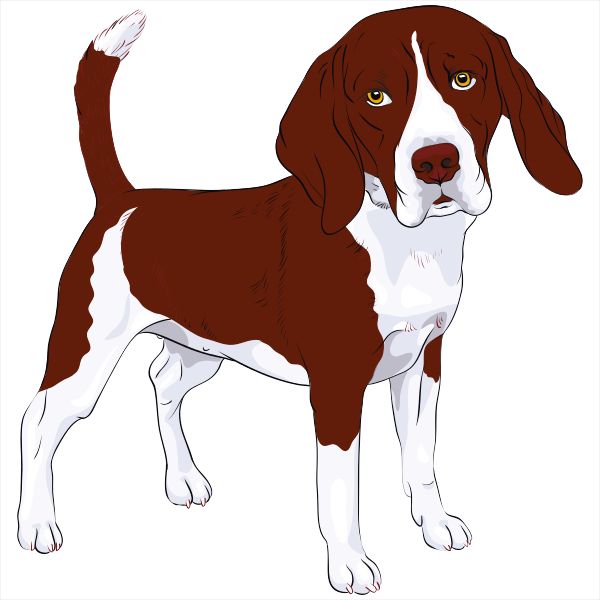
A white & chocolate or brown & white Beagle is a permissible color pattern by AKC standards.
But I can’t imagine that these dogs are actually white with solid chocolate markings. Because it would just make so little sense to ban black and white but allow brown and white.
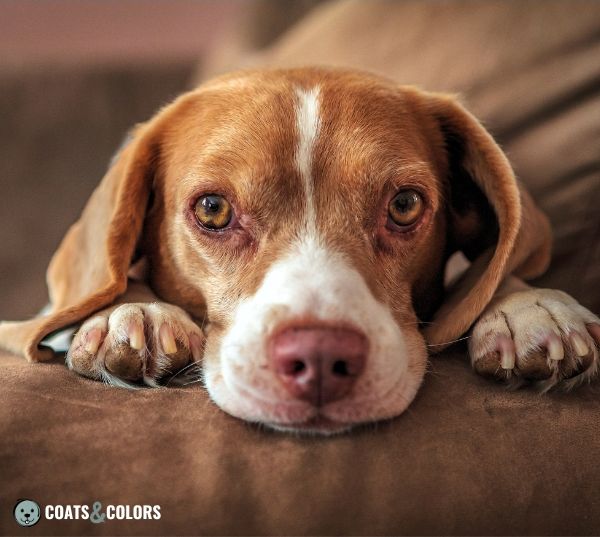
I guess it is possible that at least some “brown & white” Beagles might actually be just brown, white & tan dogs but with extended white spotting that covers most of their red markings.
Liver eumelanin right next to orange-red pheomelanin can have such low contrast that it can give the illusion of “solid brownish patches” on a white dog.
Tan & White Beagle

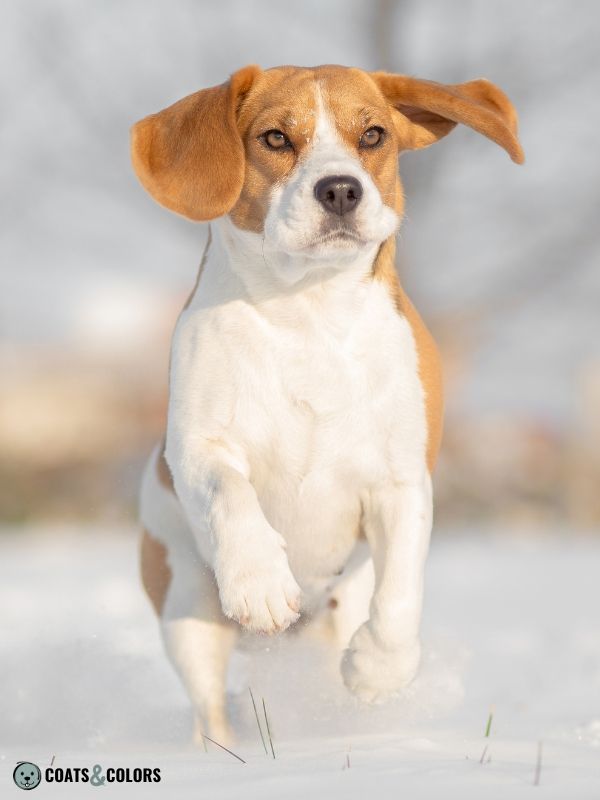
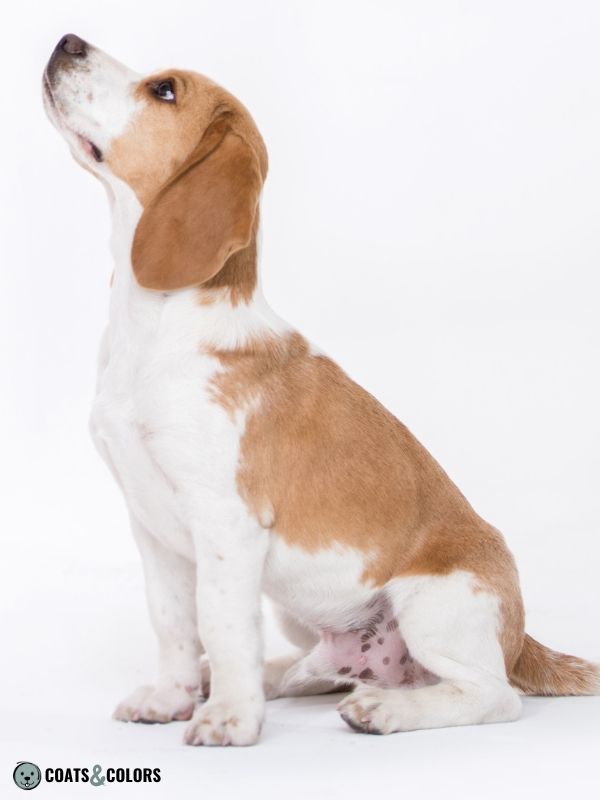
Phaeomelanin pigment can have different shades, in Beagles anything between pale cream yellow to orangey red. And tan is the most common shade of phaeomelenin seen in bicolored Beagles.
A tan & white beagle is actually a solid tan dog but with white markings hiding some of the color. Tan is lighter than red bit still dark enough so you can easily spot the solid yellow patches.
In genetic terms, tan Beagles are recessive red (e/e).
These dogs simply can’t switch from tan pigment to black pigment.
So whatever message their pattern tries to convey (such as a black saddle) doesn’t reach their pigment cells which end up just producing yellow pigment forever.
This is why recessive red can cover any other pattern in a dogs phenotype.
Tan & white Beagles don’t produce any black hairs, not even in their puppy coat.
But recessive red Beagles still produce eumelanin (most often black) which can be observed in their skin and eye pigment. But like all recessive red dogs they are prone to fading nose pigment.
And depending on their genotype, they can also come with a blue or chocolate nose and lighter eyes.
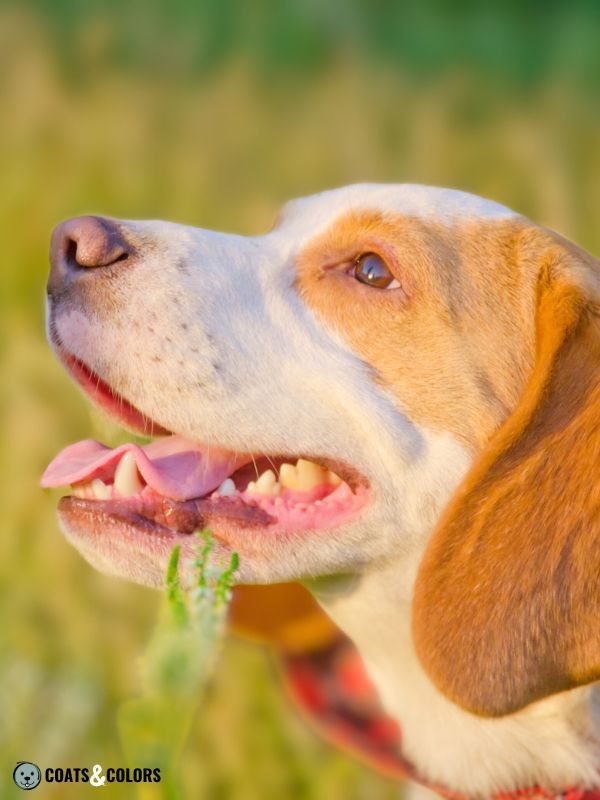
One trait seen only in some recessive red and white dogs is lacing around the edges of their color patches. Instead of roundish patches with clean edges they end up with torn and very ragged edges.
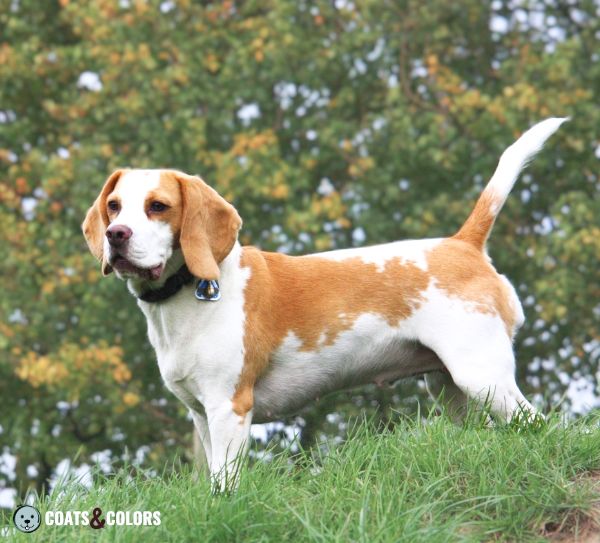
Red & White Beagle
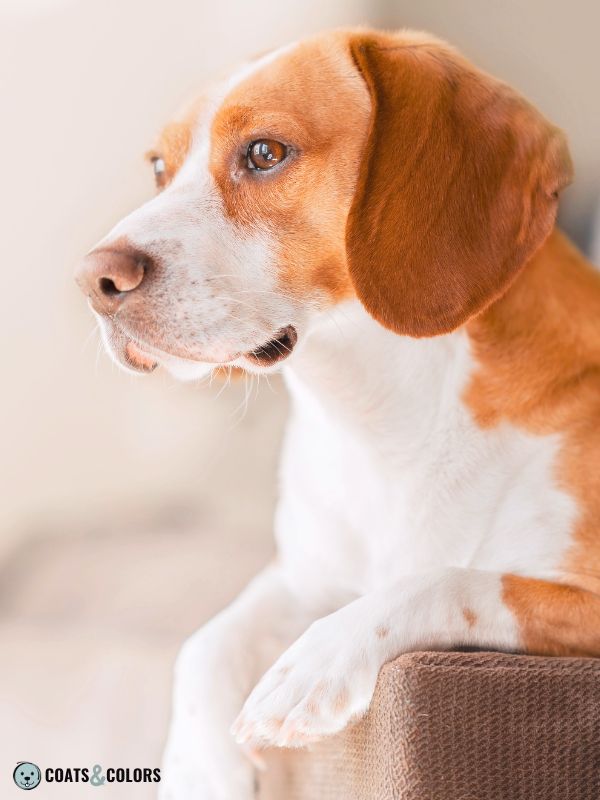


The darkest shade of phaeomelanin is found on red & white Beagles. The color intensity on a red Beagle ranges from orange to mahogany red.
But there is no hard line where dark tan ends and red begins.
These dogs are also recessive red and can only ever produce red pigment.
Color patches on a bi-colored orange Beagle can easily be spotted at birth because of their high contrast they provide next to white markings.
Lemon & White Beagle
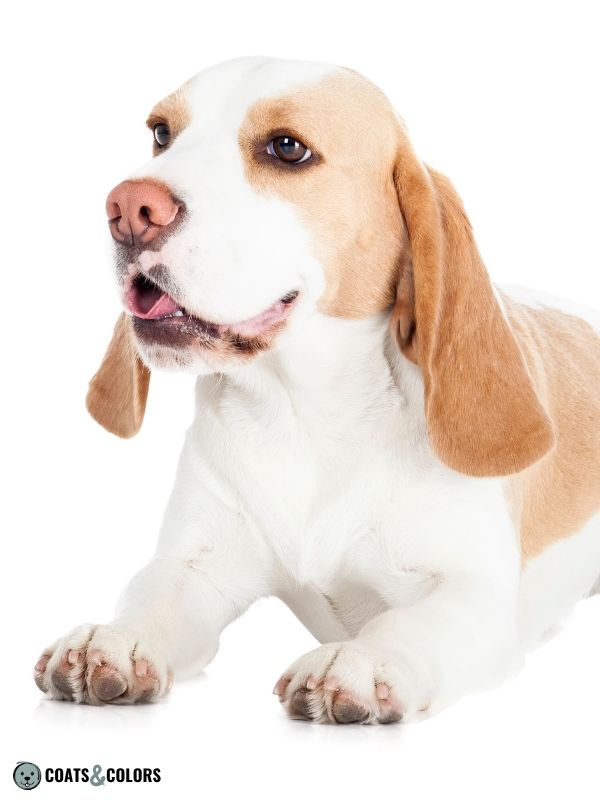


A lemon-colored Beagle is recessive red with a very low phaeomelanin intensity.
These bi-colored dogs are born with creamish-white patches. Some puppies might appear almost white at birth.
Their markings darken just little over time. So you end up with a light-colored Beagle with light yellow to honey-colored patches.
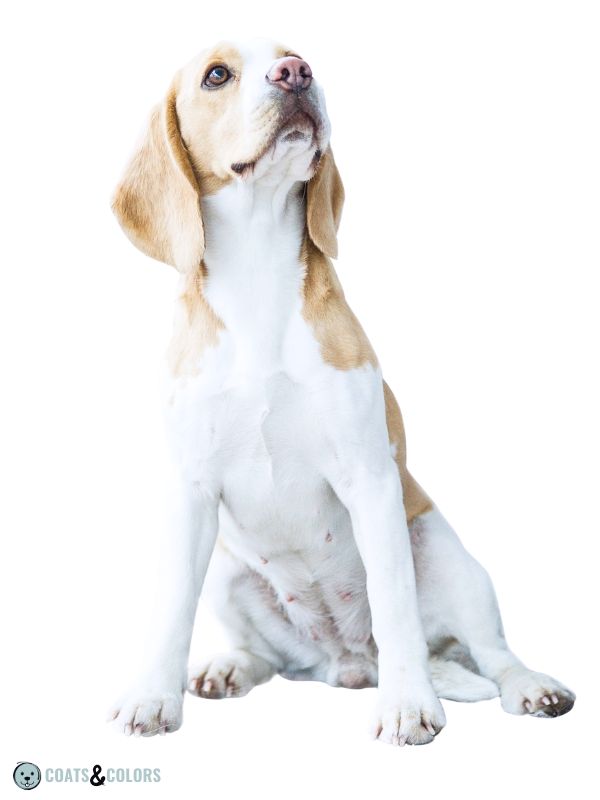
Lemon-colored Beagles are considered somewhat rare.
Interestingly, while faint yellow pigment is perfectly fine in a bicolor lemon Beagle, it is considered too light for the markings on a tricolor Beagle where it is referred to as “fawn“.
Hare-Pied Beagle



Did you know that Beagles have the ancient domino allele eA?
This gene variant at the E-Locus is typically associated with Northern breeds such as Huskies.
But somehow, the same mutation ended up in Hounds and spread across breeds such as the Beagle, Drever or German Hound, likely from crossbreeding a long time ago before studbooks closed.
What does domino do?
Well, domino restricts eumelanin production.
It causes lighter undercoat, creates light banding on black hairs and makes black areas smaller.
Black hairs get a paler tan-colored root. And domino has the tendency to lighten red pigment although there are many pied Beagles that still express a strong red intensity.
Since it is the most common pattern by far, basically all known domino cases in beagles occur on a black-tricolor saddle pattern.
And the combination of saddle and domino creates a distinct pattern called hare-pied in Beagles. This refers to the grizzled color pattern seen on wild hares.
Domino makes the saddle smaller and can remove lots of the black pigment from single hairs.
Hare-pied Beagles often end up predominantly tan-colored with black-tipped hairs along their dorsal topline and flanks.
But not every Beagle with a poorly pigmented or very faded black saddle is hare-pied! It is quite normal for tan hairs to appear inside a black saddle over time.
On the other hand, some Beagles that look like a moderately to strongly faded tricolor may actually be hare-pied. Sometimes you need puppy pictures or genetic testing to tell them apart.
In addition, domino also occurs in blue or brown based saddle patterns. But single blue or brown hair tips are less obvious on a red dog and just look like a kind of chocolate or silvery overlay.
But saddle-patterned Beagles are born black with small tan markings while truly hare-pied dogs already look tan at birth and can resemble a bicolored dog but with dark shading and dark eye rims.
A typical feature of domino is a pale vertical stripe down the nose often called a butterfly nose.
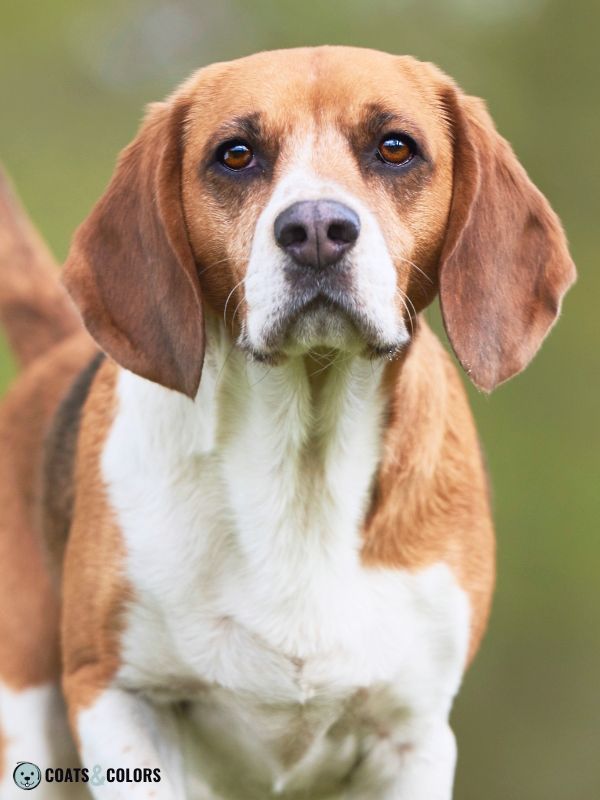
But a butterfly nose is not always a giveaway for a domino-patterned dog. There are plenty of normal tricolor Beagles out there that just have weak nose pigment.
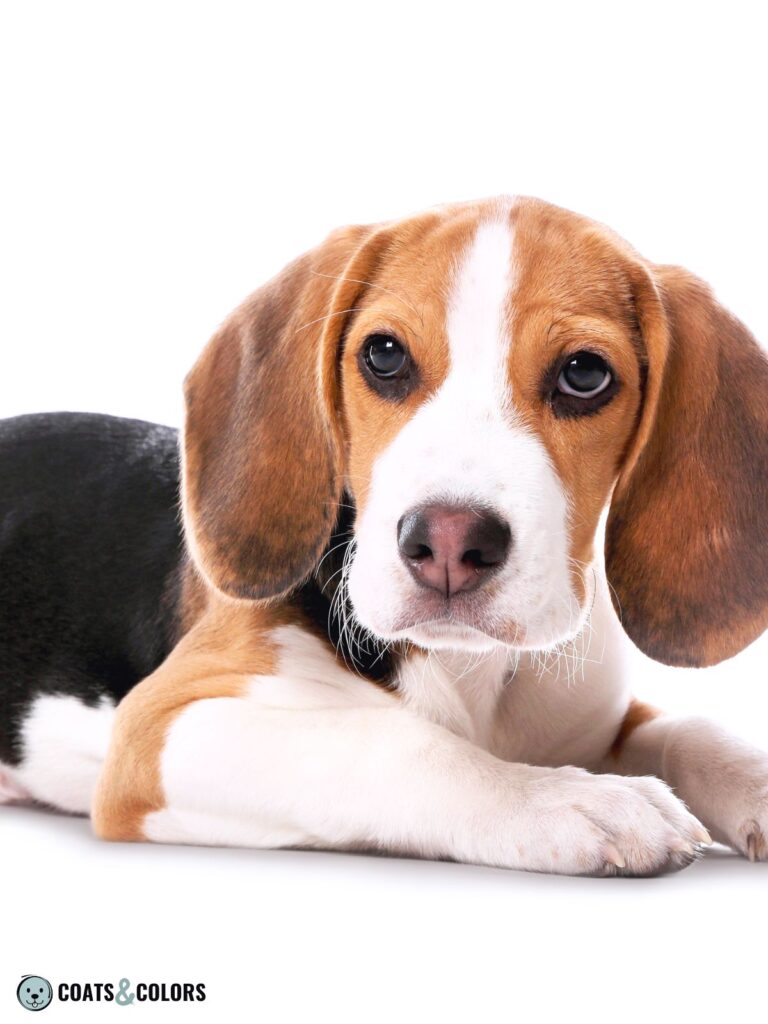
Badger-Pied Beagle
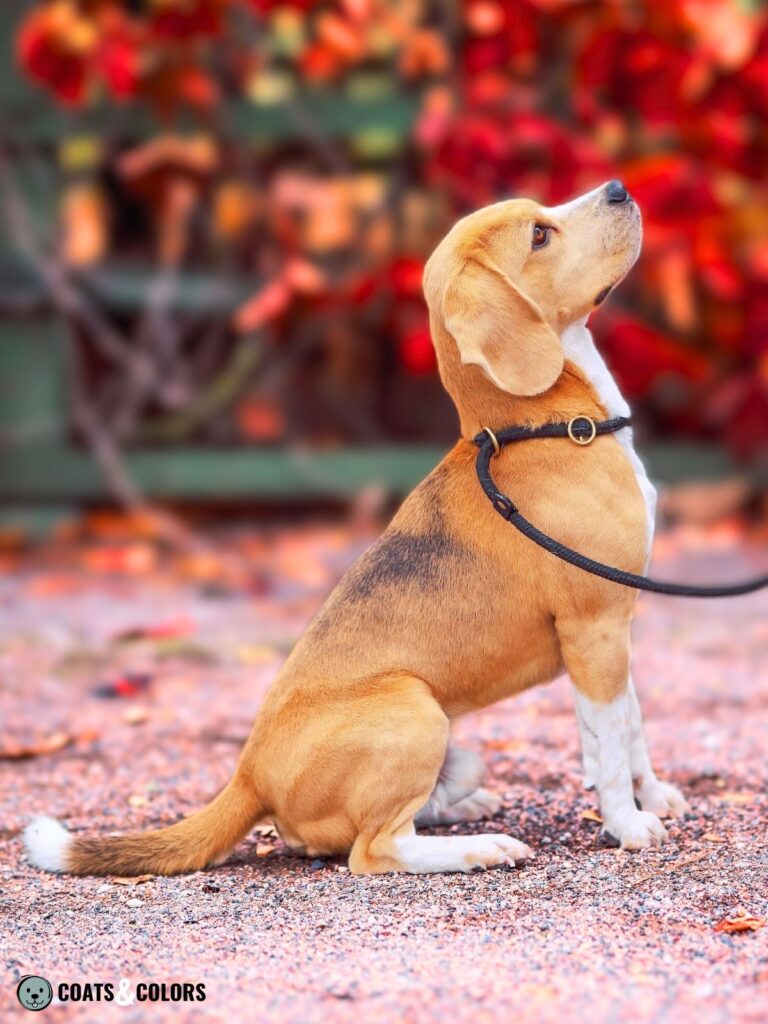




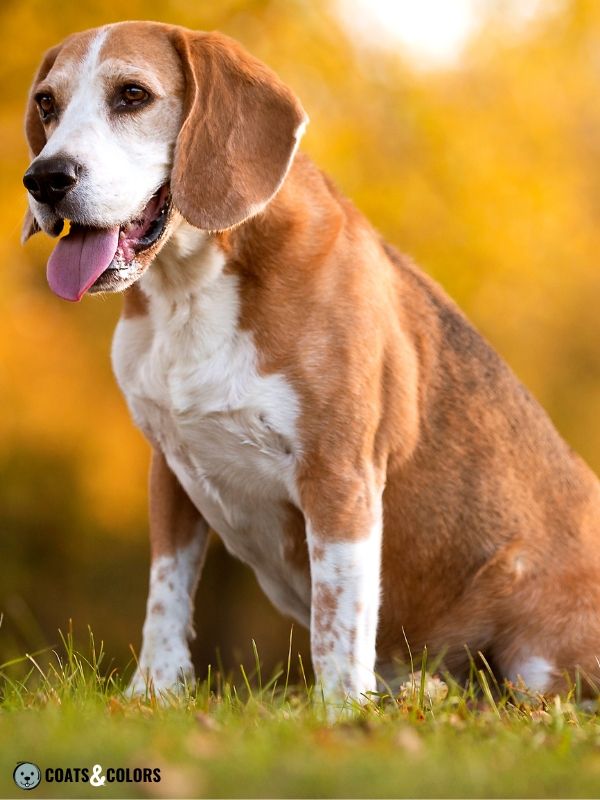
Beagles with saddle domino (ky/ky eA/- asa/asa) that keep darker patches of hair and a lighter stripe along the topline are sometimes called badger-pied.
But there really is no clear rule about what’s unique about a badger-pied pattern. All of these dogs could also be called hare-pied.
Again, these dogs are born tan with black-tipped hairs on their back. Don’t confuse them with normal tricolor Beagles that just have some fading going on.
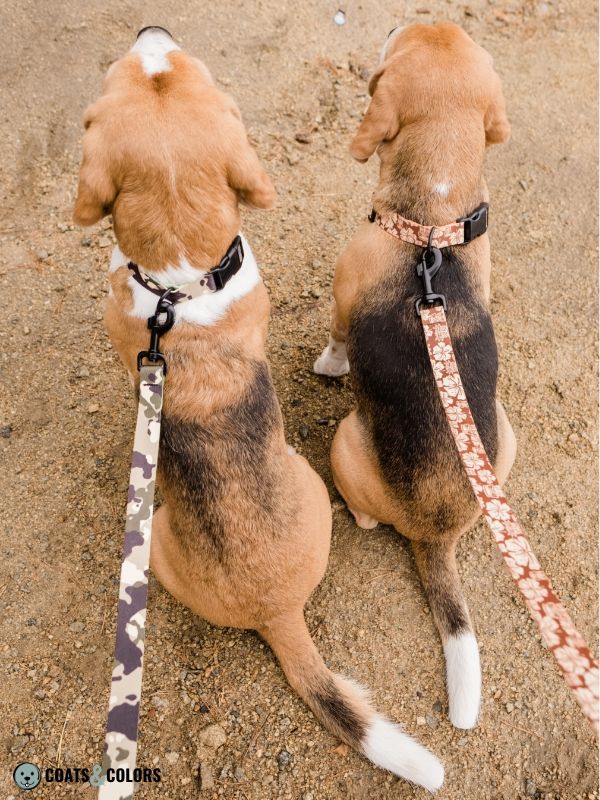
Lemon-Pied Beagle

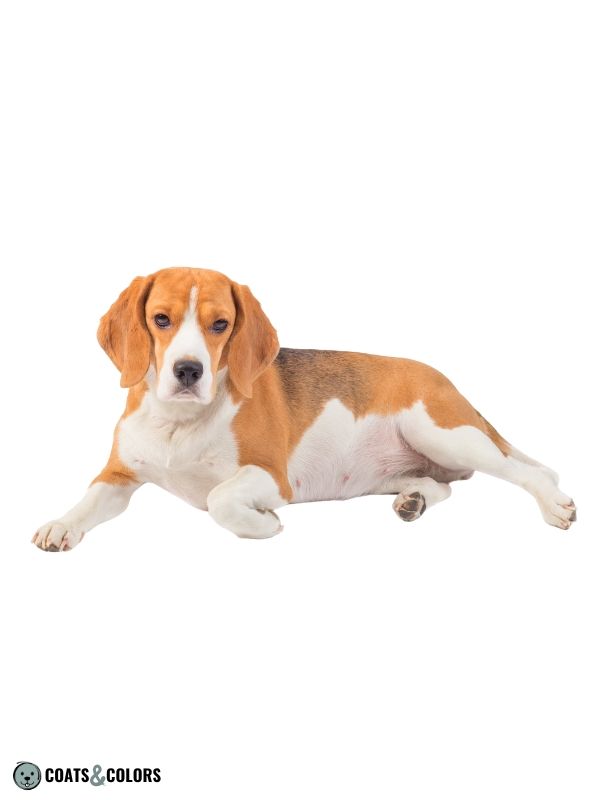
This is one of the more rare beagle colors.
Dogs that are genetically saddle domino but end up with light tan pigment and barely any black hairs in their coat are sometimes called lemon-pied.
If a dog that appears almost tan &white but has single black hairs on his body he is in fact lemon-pied. That is because bi-colored yellow dogs wouldn’t be able to produce these black hairs.
Lemon-pied is considered rare and happens when a dog has a very, very faded saddle and already had very pale yellow pigment to begin with that was lightened further by domino.
White Beagle
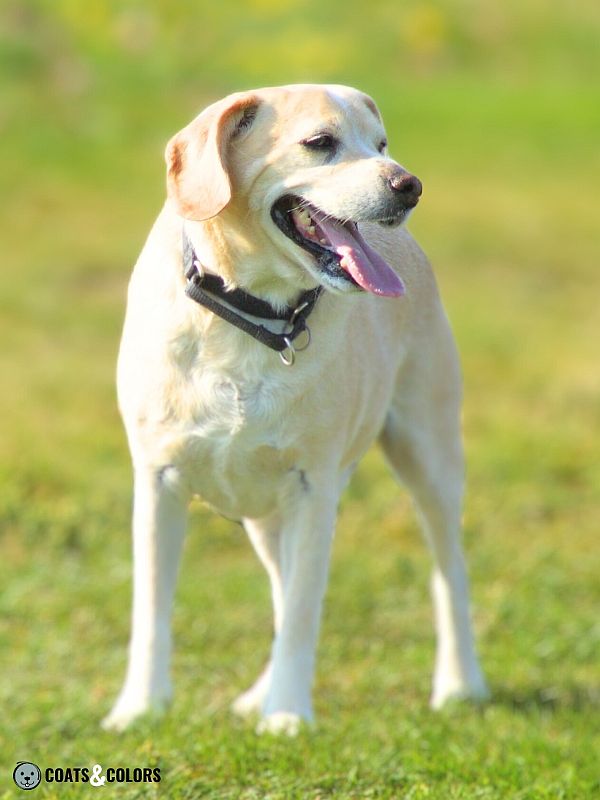

The AKC doesn’t inlcude white as a standard color.
But the KC and FCI accept solid white as a standard color in Beagles.
But there is not too much information about all-white Beagles.
One possible cause for a solid white coat might be extended piebald spotting that covers most of the dog. But this would also cause a high chance for blue eyes which are a no-no in Beagles.
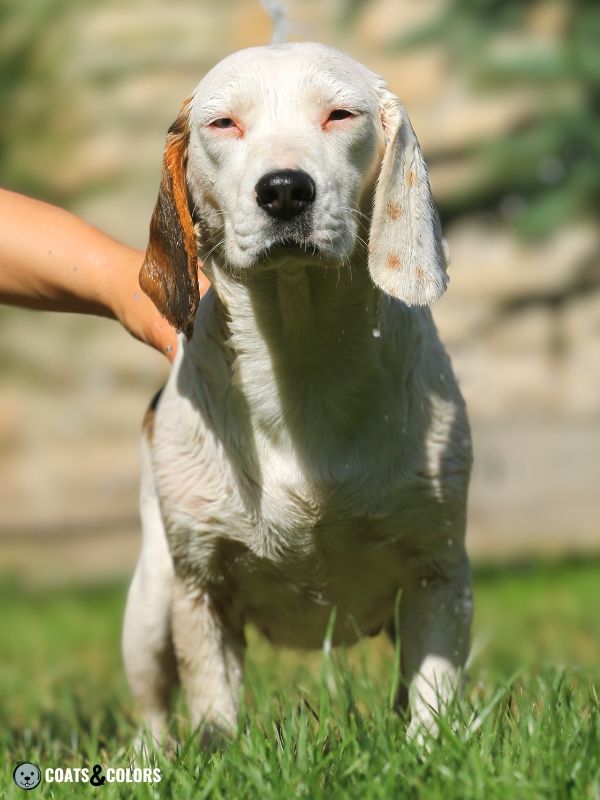
Images of the elusive pure white Beagle most often show dogs with faint cream or light biscuit markings. So maybe these are just lemon-white dogs with extra pale pigment intensity?
The only clue the FCI standard provides is that pure white Beagles should never be mottled.
Sure, yellow ticking would take away from the illusion of a solid white Beagle.
Bluetick and Redtick Beagles


Ticking is common in many hunting breeds.
Can beagles have spots? Yes, they do!
A small number of Beagles expresses mottles or even roan patterns in their coat. This seems to be more common in hunting lines while breeders selected for solid white legs for conformation.
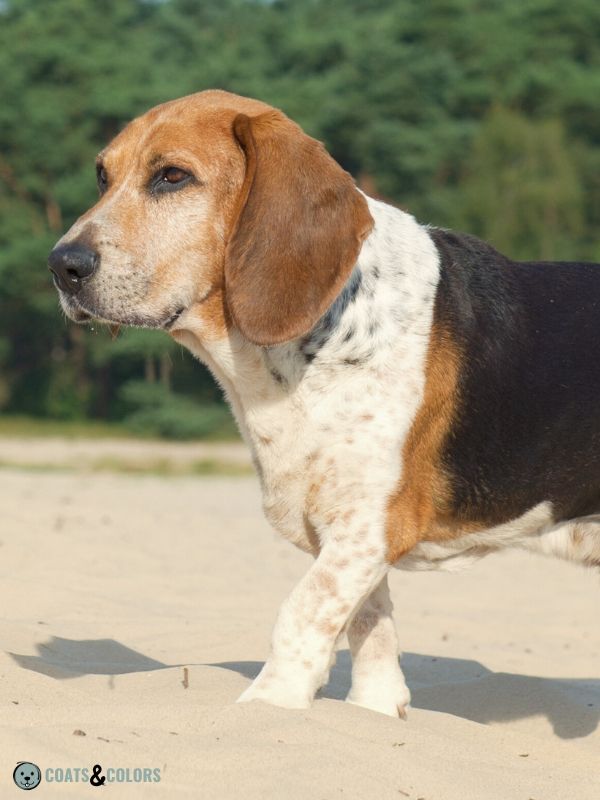
Ticking on a spotted Beagle is not present at birth. But over the first few weeks of life it begins to add small dots of pigmented coat into white areas creating a Beagle with spots.
The neat thing about ticking is that all dots have the exact color the coat would have had at their exact location if it didn’t end up covered by white spotting.
Hence, on a red & white dog, all ticking is expected to be red aka “redtick”.
And a lemon-spotted beagle has lemon-colored ticking.
But on a tricolored dog some dots may be black and others red, depending on the location of the white markings. If the white covers red in the pattern, the dots will be red. But if the white covers black coat, the dots will be black.
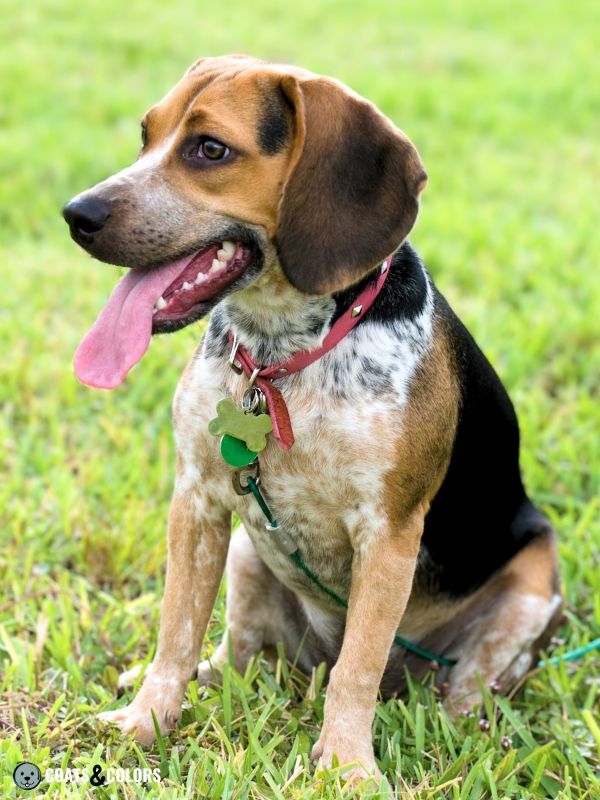
Any pattern with white can come with ticking. But the more white a dog’s coat has the more canvas it provides for ticking.
Also, ticking can be more or less intense.
The idea that there are different versions of ticking (mottle T and roan TR) and that they create a dose-dependent effect. So a dog with TR/- is roaned, a dog with T/T has heavy ticking and T/t only causes some scattered dots on a Beagle’s legs and muzzle.
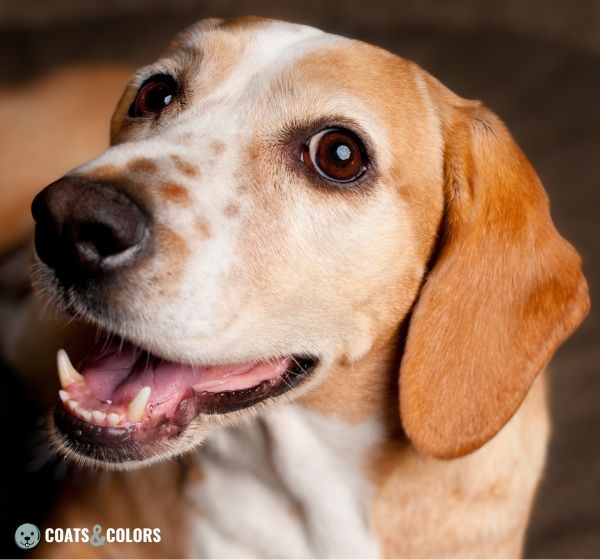
Lots of black ticking on white often looks a little grayish due to black and white hairs being mixed. This is why many breeds misleadingly call this blue or bluetick.
Somehow the AKC prefers “black, tan & bluetick” over “black, tan & redtick“.
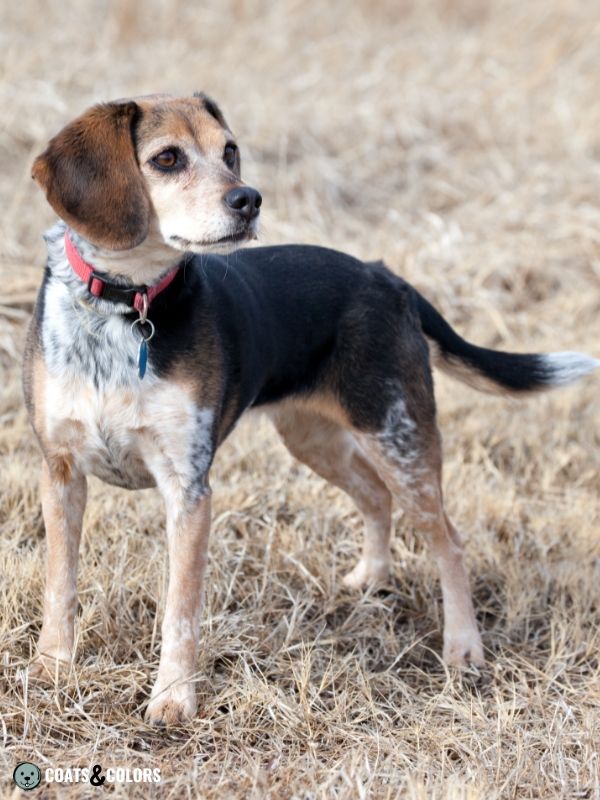
This indicates that most ticked conformation dogs have a pattern with lots of solid black patches.
This simply increases the likelihood that a white pattern will cover areas where the coat would have been black. And this is necessary to produce black ticking or bluetick.
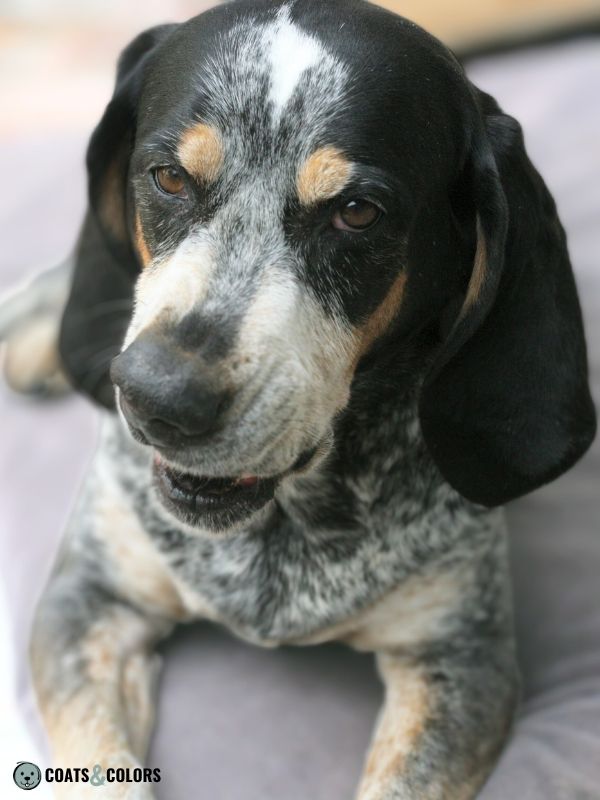
But most Beagles come with black and tan in their pattern.
So their ticking is expected to be black and tan. But white spotting on saddle-patterned dog can also be only red as long as the white only covers the red muzzle, legs, shoulders and thighs.
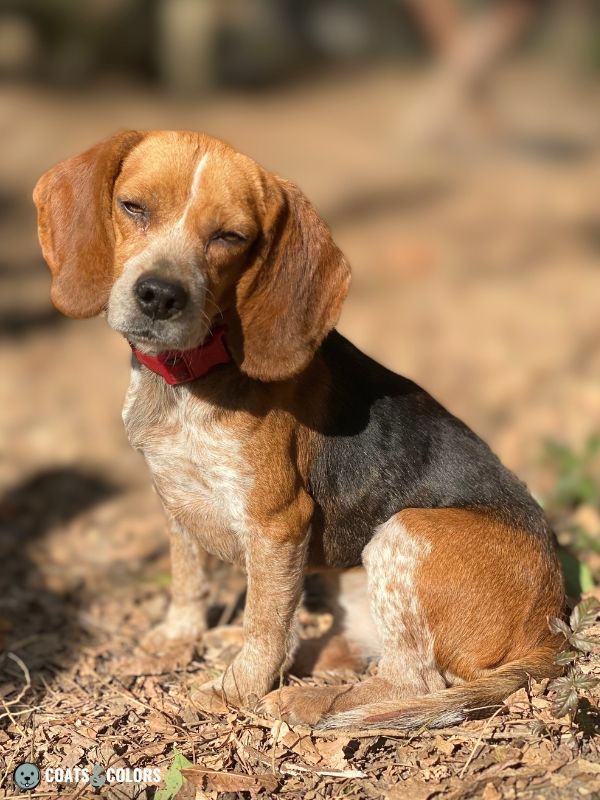
Of course, if a Beagle has brown, blue or lilac pigment in his saddle pattern, some of his spots may also be brown, blue or lilac.
Some breeders sell puppies with brown tricolor and ticking as redticks (because they confuse brown and red). And most dogs dubbed as redtick are simply bicolor such as red & white with ticking.
Non-Standard Beagle Coat Colors
Non-standard colors occur in any dog breed. Most decent breeders avoid them, others breed them on purpose despite being considered undesirable.
Some non-standard colors are achieved by crossbreeding to introduce a non-standard trait.
But sometimes these non-standard colors happen by accident due to recessive alleles.
Recessive traits will only be expressed in dogs that inherited one copy each from their dam and sire. While dogs with just one copy can carry and may pass on these traits over generations.
Solid-Colored Beagle
European show Beagles are essentially fixed for homozygous piebald (sP/sP). The FCI standard demands that every Beagle has to have at least some up their belly.
But the S allele is still around in US show and field lines.
Heterozygous dogs (S/sP) are expected to have less white spotting.
And dogs that get one copy of non-piebald (S) from each of their parents (making them S/S) don’t have any white spotting at all.
And this can cause puppies being red, tan, lemon all over. Because it is bicolor minus the white.
Masked Beagle

Some Beagles have the gene variant for dark melanistic masks (Em)[4].
Recessive red (e/e) bicolor dogs can’t be Em/- at the same time. But on tricolor dogs, a mask adds a layer of black pigment on top of the tan face markings.
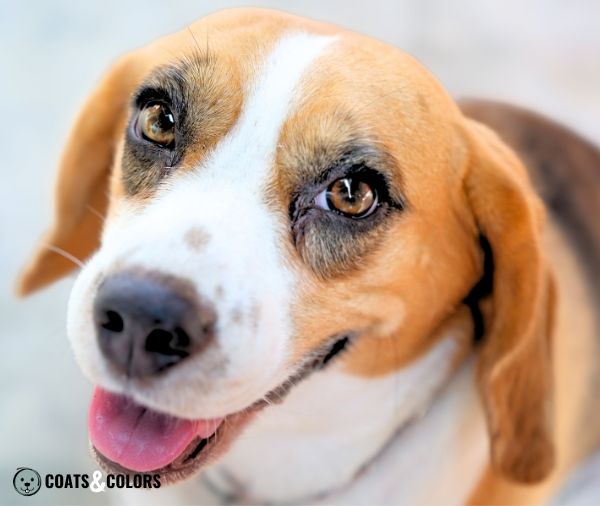
On Beagles, masks are rare and often covered at least partially by white on the muzzle. But moderatley sized masks often tend to add black pigment around the eyes.
Since this is not in line with the “soft expression” the breed standards ask for, it is not a preferred trait in Beagles but sure happens in field lines where color is not a major concern.
Merle Beagle
Some breeders sell merle Beagles which they call by fancy names such as “Norwegian Blue Beagle” or “Russian Blue Beagle“.
But merle is not a standard color in Beagles and was introduced by crossbreeding.
Merle only affects eumelanin where it dilutes random patches of black pigment. With a black saddle being the traditional pattern in Beagles, merle is restricted to the black saddle.
A blue merle Beagle most often refers to a black-based tricolor merle.
Merle is not the same as ticking.
A bluetick pattern appears some weeks after birth and adds pigment to white areas of coat. But merle is already present at birth and removes pigment from black coat.
Sable Beagle
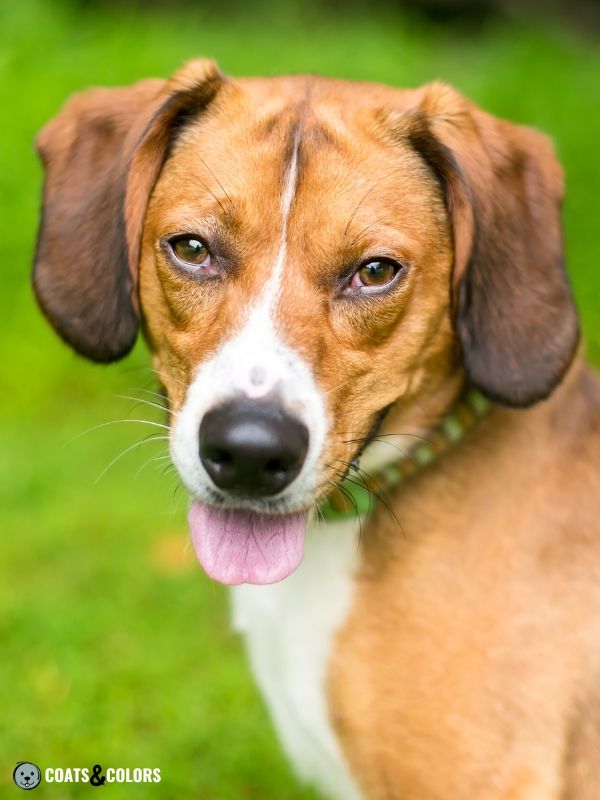
Surprisingly, a very small number of Beagles test positive for sable (not sure if Ay or Ays)[4].
Clear sable (Ay) with no black hairs in the adult coat may resemble a recessive red pattern. And shaded sable (Ays) with its tan coat and black hair tips along the back could easily pass as hare-pied.
This might explain why sable was never fully eliminated from the Beagle gene pool.
Brindle Beagle
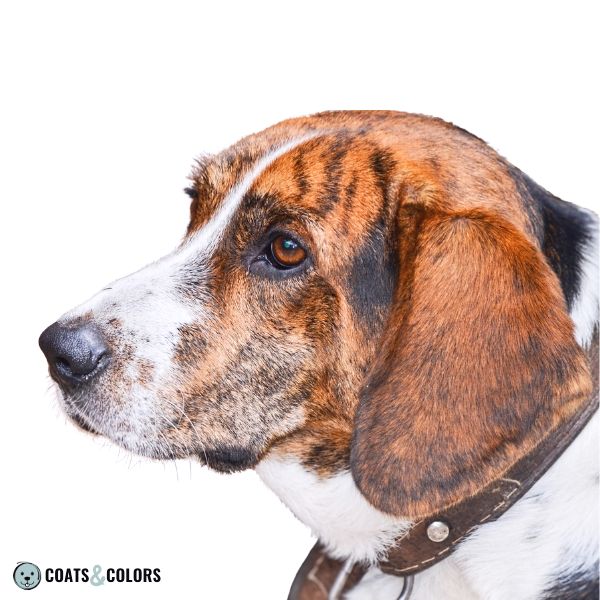
Brindle (kbr) adds dark vertical stripes on top of a tricolor Beagles’s tan markings.
Beagles with a bicolor pattern can not be brindle.
In Beagles, bi-colored dogs can either only produce phaeomelanin (e/e) or, somewhat more rare, can only produce eumelamin (a/a). So they can’t express both, black stripes on a red base color.
But these dogs might still carry brindle.
Brindle is not a standard color and likely the result of crossbreeding. Since it’s dominant over a non-brindled saddle pattern (ky/ky), it is easy to detect and select against.
Beagle Coat Colors Overview
The breed standard describes all the different traits a Beagle should have.
This includes his conformation and temperament but also the coat texture as well as Beagle colors and markings of an ideal representative of this breed.
The major kennel clubs often use their own standards provided by their affiliated breed club. These standards are usually similar in their general outline but can differ in details like coat color.
When you talk about “all Beagle colors” you should consider who you talk to.
AKC Beagle colors allow for more variation when compared to FCI countries since they don’t ban brown and blue dogs from conformation events.
Let’s see what different clubs have to say about the accepted Beagle coat color patterns[1-3]:
| AKC | FCI | KC | |
|---|---|---|---|
| Black Tricolor Black, Red & White Black, Tan & White Black, White & Tan (saddle-patterned) | ✅ | ✅ | ✅ |
| Black Tricolor Mottle Black, Tan & White Mottle Blue, White & Tan Mottle Black Tan & Bluetick (“blue” meaning black ticking) (saddle-patterned) | ✅ | ✅ | ✅ |
| Chocolate Tricolor Brown White & Tan (saddle-patterned) | ✅ | – | – |
| Chocolate Tricolor Mottle Brown White & Tan Mottle (saddle-patterned) | ✅ | – | – |
| Blue Tricolor Blue, Tan & White (“blue” meaning color dilution) (saddle-patterned) | ✅ | – | – |
| Blue Tricolor Mottle Blue, Tan & White Mottle (“blue” meaning color dilution) (saddle-patterned) | ✅ | – | – |
| Lilac Tricolor Lilac, Tan & White (saddle-patterned) | ✅ | – | – |
| Lilac Tricolor Mottle Lilac, Tan & White Mottle (saddle-patterned) | ✅ | – | – |
| Black & Tan | ✅ | – | – |
| Lemon & White | ✅ | ✅ | ✅ |
| Lemon & White Mottle | ✅ | ✅ | ✅ |
| Red & White | ✅ | ✅ | ✅ |
| Red & White Mottle | ✅ | ✅ | ✅ |
| Tan & White | ✅ | ✅ | ✅ |
| Tan & White Mottle | ✅ | ✅ | ✅ |
| Black & White | – | ✅ | ✅ |
| Black & White Mottle | – | ✅ | ✅ |
| Brown & White | ✅ | – | – |
| Brown & White Mottle | ✅ | – | – |
| Hare-Pied | (✅) | ✅ | ✅ |
| Hare-Pied Mottle | (✅) | ✅ | ✅ |
| Badger-Pied | (✅) | ✅ | ✅ |
| Badger-Pied Mottle | (✅) | ✅ | ✅ |
| Lemon-Pied | (✅) | ✅ | ✅ |
| Lemon-Pied Mottle | (✅) | ✅ | ✅ |
| White | – | ✅ | ✅ |
Brackets indicate color names that are not mentioned in the breed standard without excluding them.
Beagle Coat Color Genetics
Different colors of Beagles are caused by pigment color and pigment distribution.
A dog’s coat gets its colors from two pigment types called eumelanin and phaeomelanin. Different proportions of colors in a particular dog’s coat create different patterns.
And other genes cause different colors on individual Beagles, for example red or tan phaeomelanin as well as black, brown, blue or lilac eumelanin.
But Beagles, like most dog breeds, can only produce some of all the possible colors and patterns. These are the genes and alleles involved in the patterns and colors of Beagles:
| E-LOCUS | Em = melanistic mask (rare!)[4] E = normal pattern eA = ancient domino (“pied”) e = recessive red |
| K-LOCUS | ky = normal pattern |
| A-LOCUS | Ay = sable (US field lines, very rare!)[4] asa = saddle pattern at = tan points a = recessive black (???) |
| B-LOCUS | B = black b = brown |
| D-LOCUS | D = normal pigment d = diluted pigment |
| S-LOCUS | S = no spotting sP = white spotting |
| M-LOCUS | m = non-merle |
Eumelanin Colors
All European showlines are fixed for black eumelanin.
While black is still the most common color, US Beagles can also be chocolate, blue or lilac instead!
Eumelanin is not expressed in every coat color pattern. But it’s always eumelanin that gives color to a dog’s nose, skin, nails or eyes.

Phaeomelanin Intensity
The phaeomelanin intensity mentioned in Beagle standards are red, tan, fawn, and lemon.
With red being a rich orangey color, tan being a lighter blond to yellow color, and lemon being a very pale cream color.
According to the European breed standards, a Beagle can also be solid white which might actually refer to dogs with very very, very faint creamish markings.

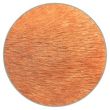
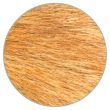
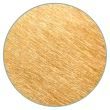
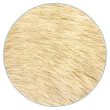
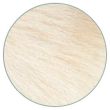
Dogs can be bicolor with red & white, tan & white, or lemon & white markings.
Lemon-white is considered a somewhat rare color in Beagles and some breeders breed for light pigment and market their puppies as lemon drop Beagle.
Likewise, the phaeomelanin on saddle-patterned Beagles can be red, tan or fawn (which would be the same as lemon on a bi-colored dog).
Interestingly, the AKC lists black, fawn & white as a non-standard color indicating they don’t like light yellowish pigment on their tricolor dogs.
White Spotting
Most Beagles have at least some white spotting from piebald.
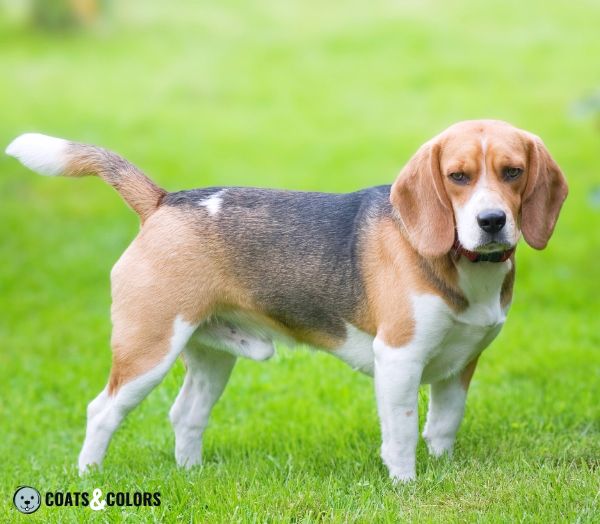
White is also necessary for ticking to be expressed.
And it is the third “color” besides black and tan that makes a dog “tricolor“. In other words, a tricolor Beagle is a saddle-patterned dog, but some areas are just not pigmented because they lack pigment cells.
Pigment cells are sent out from top to bottom during embryonic development. But if piebald is present, some cells never reach their destination.
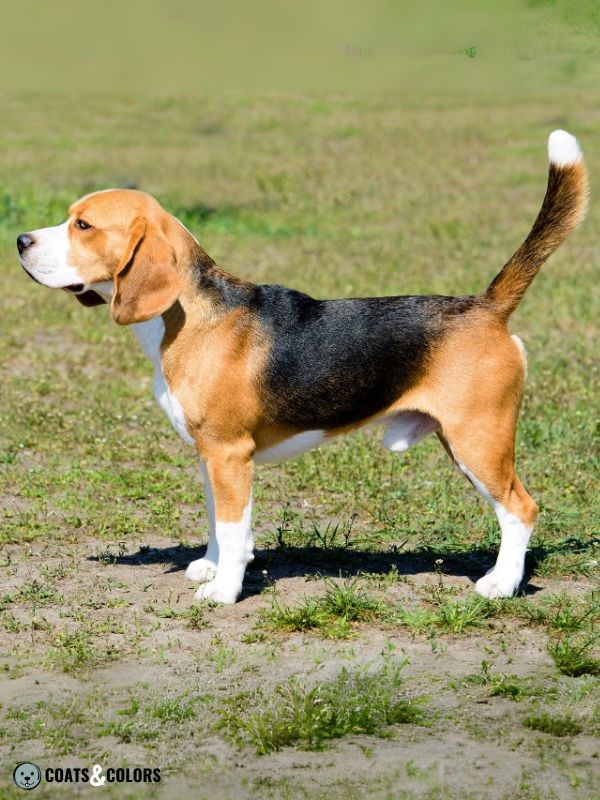
The piebald allele (sP) interferes with the normal distribution of pigment cells throughout the skin. Hence, it causes a true lack of pigment in some hairs.
The first areas to be affected are usually on the lower body and chest.
But most Beagles are fixed for two copies of piebald (sP/sP) anyway, which usually (but not always) leads to a moderately-sized spotting pattern.
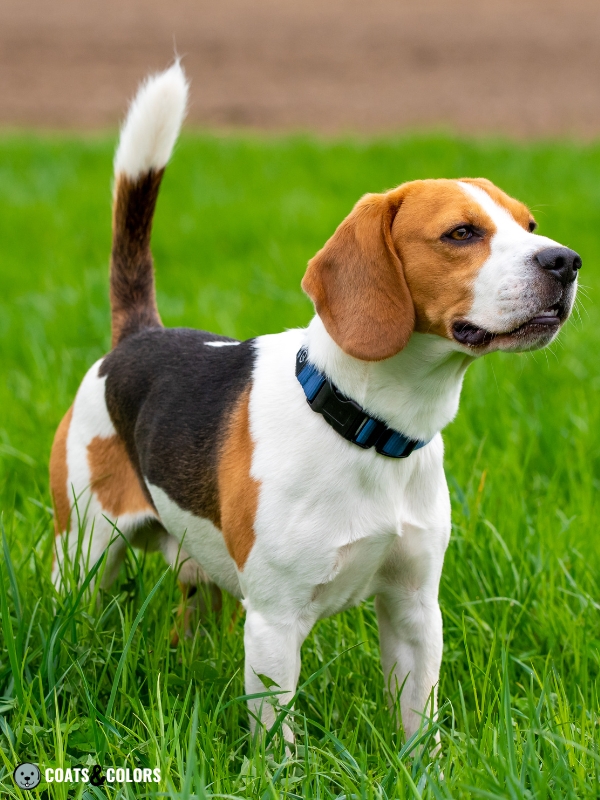





The FCI standard even calls for the tip of the sternum (which should be just behind the front legs) to be white[2]. This obviously favors dogs with a piebald pattern.
The white spotting pattern seen on many Beagles resembles Irish spotting with white on the lower legs, a white tail tip, and a white blaze. Piebald is a somewhat random pattern, but selective breeding can work in favor of symmetry over time.
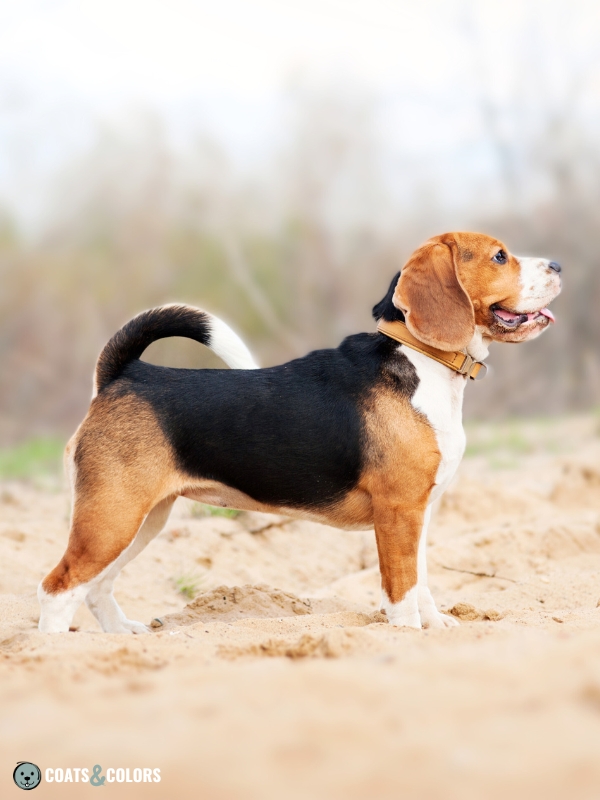
But the white markings found on Beagles are still often somewhat irregular and extend beyond an Irish spotting pattern. Their white markings often cover parts of the upper body, forehead, collar, shoulders, or thighs.
And some Beagles show even more white with some residual patches of pigmented coat only on their back and head.
If the white spotting extends into the dark saddle on the back, these Beagles are called “open-patterned“.
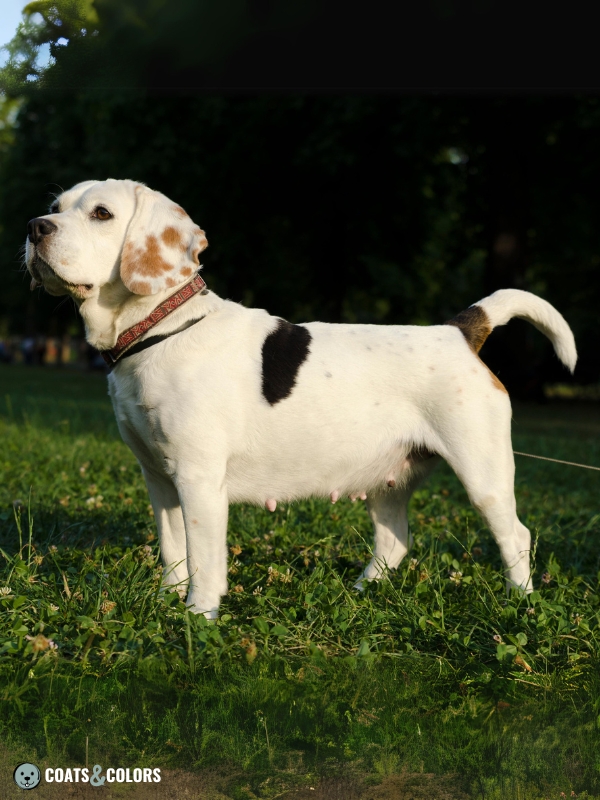





There is no true definition of the “perfect” spread of white on a Beagle. But breeders are usually discouraged from breeding for too much white.
According to the AKC website, black, tan & white and black, white & tan are standard colors while white, black & tan (meaning tricolor with white as the major color) is not.
In addition to piebald, very many Beagles show signs of whitehead.

See, with normal piebald, one of the last areas to be affected is the head.
This makes it a distinct trait from whitehead which prefers to meddle with pigment cells on the face and front of the dog before it affects other areas.
Many Beagles, even those with just moderate piebald patterns, have more white on their facial markings and front than expected from only piebald.
But all in all, the whitehead trait often is not that obvious when combined with piebald. It is more prominent in breeds that produce fully pigmented dogs with white on just their face.
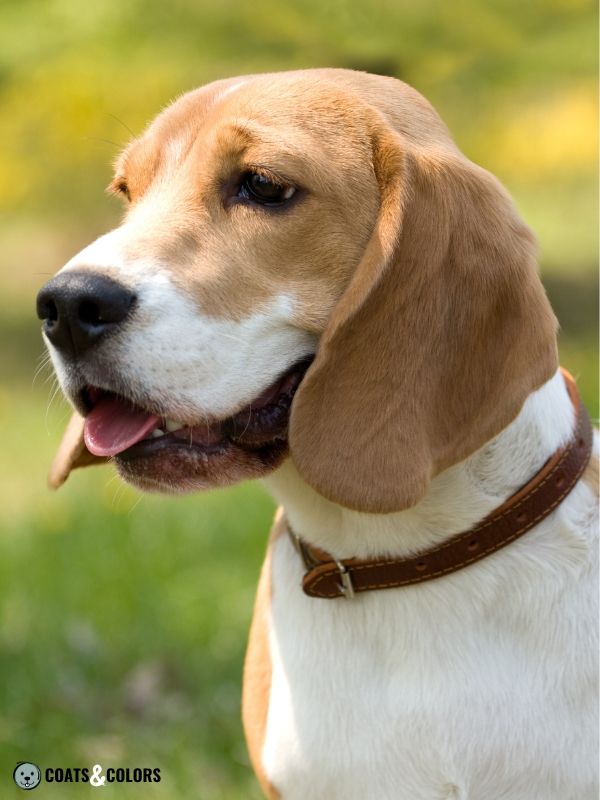





Common examples for whitehead in Beagles are wide and irregular blazes, lipstick white, split faces and overall lots of white on the muzzle and face.
But too much face white increases the chance for blue eyes (and hearing loss). This gave breeders an incentive to select against extended whitehead patterns such as split faces or white heads.
Color Patterns
The accepted patterns in a dog breed describe the distribution of colors in a dog’s coat.
The AKC is very non-specific and allows “any true hound color” but without providing a definition of historic hound colors. The FCI and KC on the other hand, list all the colors they prefer to see on a Beagle and state that “no other colours are permissible“.
Different types of Beagle colors are often called “tricolor” and “bicolor”.
The most common pattern in Beagles is a saddle pattern with both types of pigment and some white spotting on top. In Beagles this is called “tricolor“.
Dogs with recessive red can only produce phaeomelanin while dogs with recessive black can only produce eumelanin. Both traits produce what Beagle breeders call “bicolor“, a dog with one color plus white.
Unraveling breed-specific lingo can be quite tricky… So bear with me, I’m just making an educated guess!
| Color Term | Genotype |
|---|---|
| Black Tricolor (black-based saddle tri) | B/- D/- ky/ky asa/asa E/- sP/sP |
| Chocolate Tricolor (brown-based saddle tri) | b/b D/- ky/ky asa/asa E/- sP/sP |
| Blue Tricolor (blue-based saddle tri) | B/- d/d ky/ky asa/asa E/- sP/sP |
| Lilac Tricolor (lilac-based saddle tri) | b/b d/d ky/ky asa/asa E/- sP/sP |
| Hare-Pied Badger-Pied Lemon-Pied (black-based saddle tri domino) | B/- D/- ky/ky asa/asa eA/- sP/sP |
| Black & Tan (black-based tan points or creeping tan, no white) | Black & Tan: B/- D/- ky/ky at/at E/- S/- Creeping Tan: B/- D/- ky/ky asa/at E/- S/- |
| Red & Black (black-based saddle, no white) | B/- D/- ky/ky asa/asa E/- S/- |
| Black, Tan & Bluetick (black-based black tri mottled) | B/- D/- ky/ky at/at E/- sP/sP T/T B/- D/- ky/ky asa/at E/- sP/sP T/T + Ticking/Roan |
| Black, Tan & Redtick (black-based saddle tri mottled) | B/- D/- ky/ky asa/asa E/- sP/sP + Ticking/Roan |
| Red & White Tan & White Lemon & White (recessive red) | e/e sP/sP + phaeomelanin intensity |
| White (recessive red) | e/e sP/sP + very low phaeomelanin intensity |
| Black & White (recessive black) | B/- D/- ky/ky a/a E/- sP/sP |
| Brown & White (recessive black + liver) | b/b D/- ky/ky– a/a E/- sP/sP Dogs called “brown & white” might actually be something else such as brown-based tan point tri. |
Beagle Eye and Nose Color
The FCI standard calls for black nose pigment.

The only exception is made for “lighter coloured hounds” where a less pigmented (but still black) nose is tolerated.
This includes the butterfly nose seen in “hare-pied” domino Beagles and the fading nose pigment seen in “bicolor” recessive red Beagles. But never badly pigmented “pink nose”.

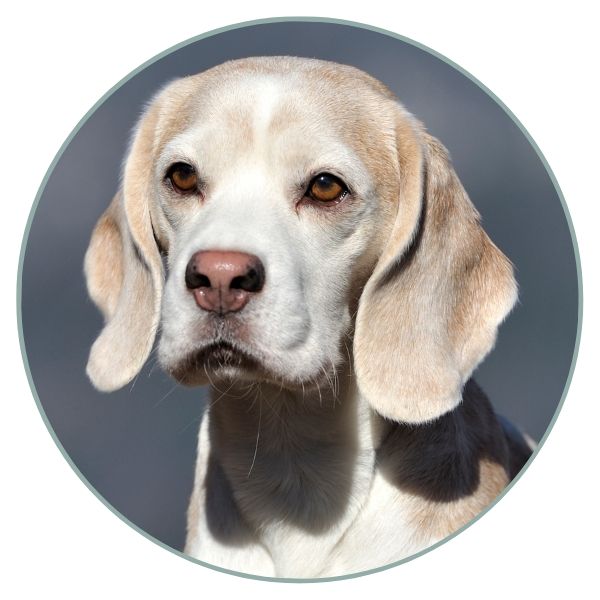

But having to have a black nose indirectly rules out any chocolate- or blue-based patterns which are considered as faults by the FCI and KC standards.
Hence, European show lines of Beagles are basically fixed for black eumelanin (B/B D/D).
Whatever a black-based Beagle’s coat color pattern, he will have brown eyes, the desired black nose, and black pigment on their lips, eye rims, paw pads, or nails.
A chocolate Beagle will also have brown nose and skin pigment. And eyes on chocolate-based dogs tend to be a little lighter and more yellowish.

The same goes for blue Beagles who will have a blue nose and even lighter eyes. And, you guessed it, a lilac Beagle has a diluted brown nose and may have greenish-to-yellow eyes.

All major breed standards call for dark brown to hazel eyes[1-3].
But eumelanin colors other than black tend to produce light eyes.
While the AKC doesn’t exclude brown, blue or lilac dogs, light or yellow eyes are still selected against[5]. Overall, Beagle eye colors should be as dark as possible and should match the dog’s coat.
All breed clubs agree that Beagles should never have blue eyes.
But blue-eyed Beagles still happen.
This is common in dogs with too much white spotting on the face and is often caused by whitehead patterns or extended piebald patterns.
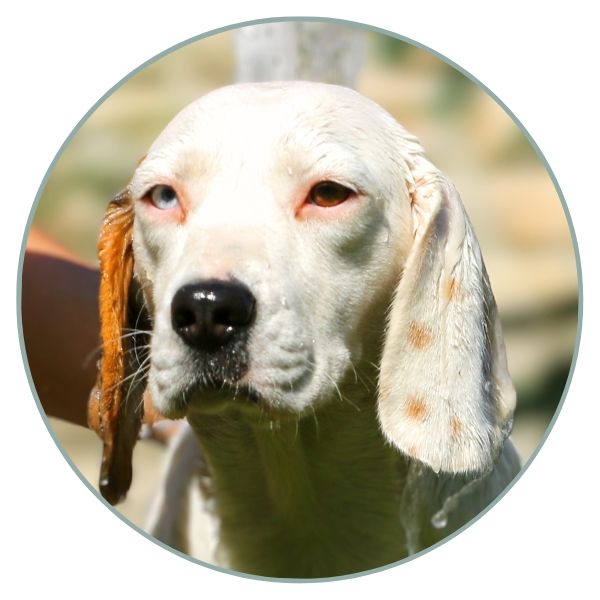

Beagle Coat Types
The Beagle is a small hound used for hunting.
He has a weatherproof and easy-to-maintain coat that should not be too soft or thin.
Typically, a Beagle’s coat is short to medium short, close, dense, and hard.
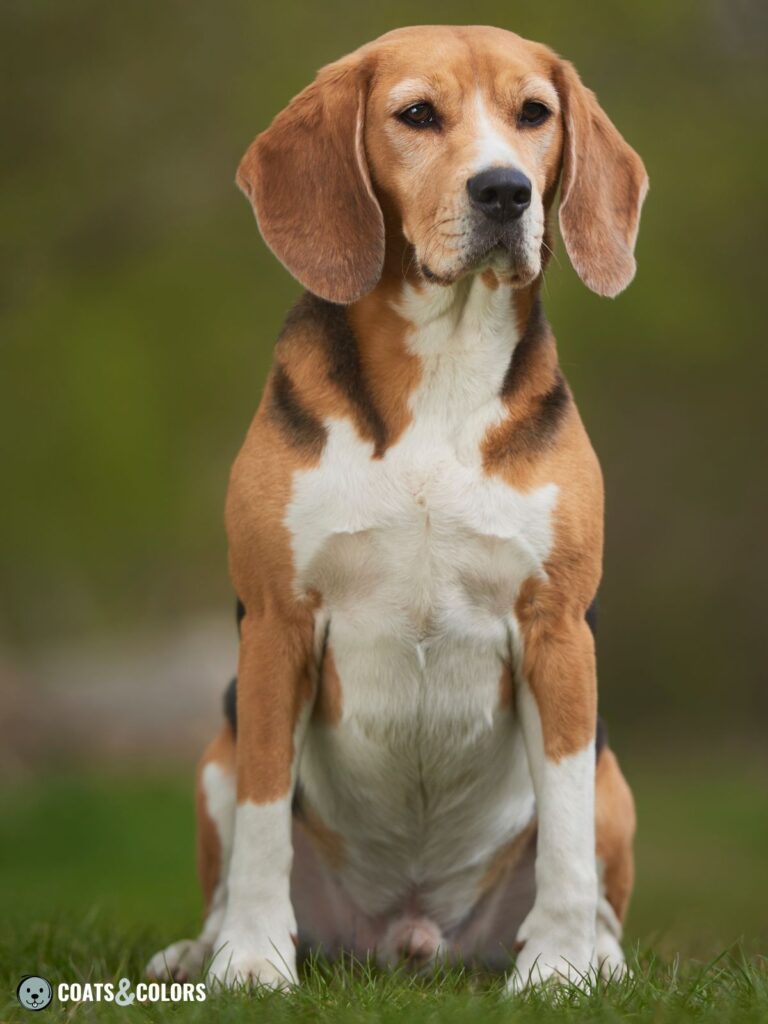
Other Coat Types in Beagles
Some less common alleles in this breed can produce a non-standard coat type[4]:
A small number of Beagles carry the long coat variant.
Breeding two carriers can result in a long-haired Beagle puppy!
The curly variant also occurs in the Beagle population. But because the hair needs to be a certain length to actually curl it is not expressed on the short-haired Beagle (thus was not selected against).
Learn More
Links
[1] American Kennel Club (AKC): Official Standard of the Beagle (pdf)
[2] Fédération Cynologique Internationale (FCI): Beagle Breed Standard (pdf)
[3] The Kennel Club (KC): Beagle Breed Standard
[4] Dreger et al. (2019). True Colors: Commercially-acquired morphological genotypes reveal hidden allele variation among dog breeds, informing both trait ancestry and breed potential. PLoS ONE 14(10): e0223995. https://doi.org/10.1371/journal.pone.0223995
[5] The National Beagle Club of America: Power Point Presentation
[6] Beagle Brief 4/2020: A Newly Discovered “Old” Color: Domino aka Pied In The Beagle.
[7] Nord, Jensen (2021). Genomic Regions Associated with Variation in Pigmentation Loss in Saddle Tan Beagles. Genes. https://doi.org/10.3390/genes12020316
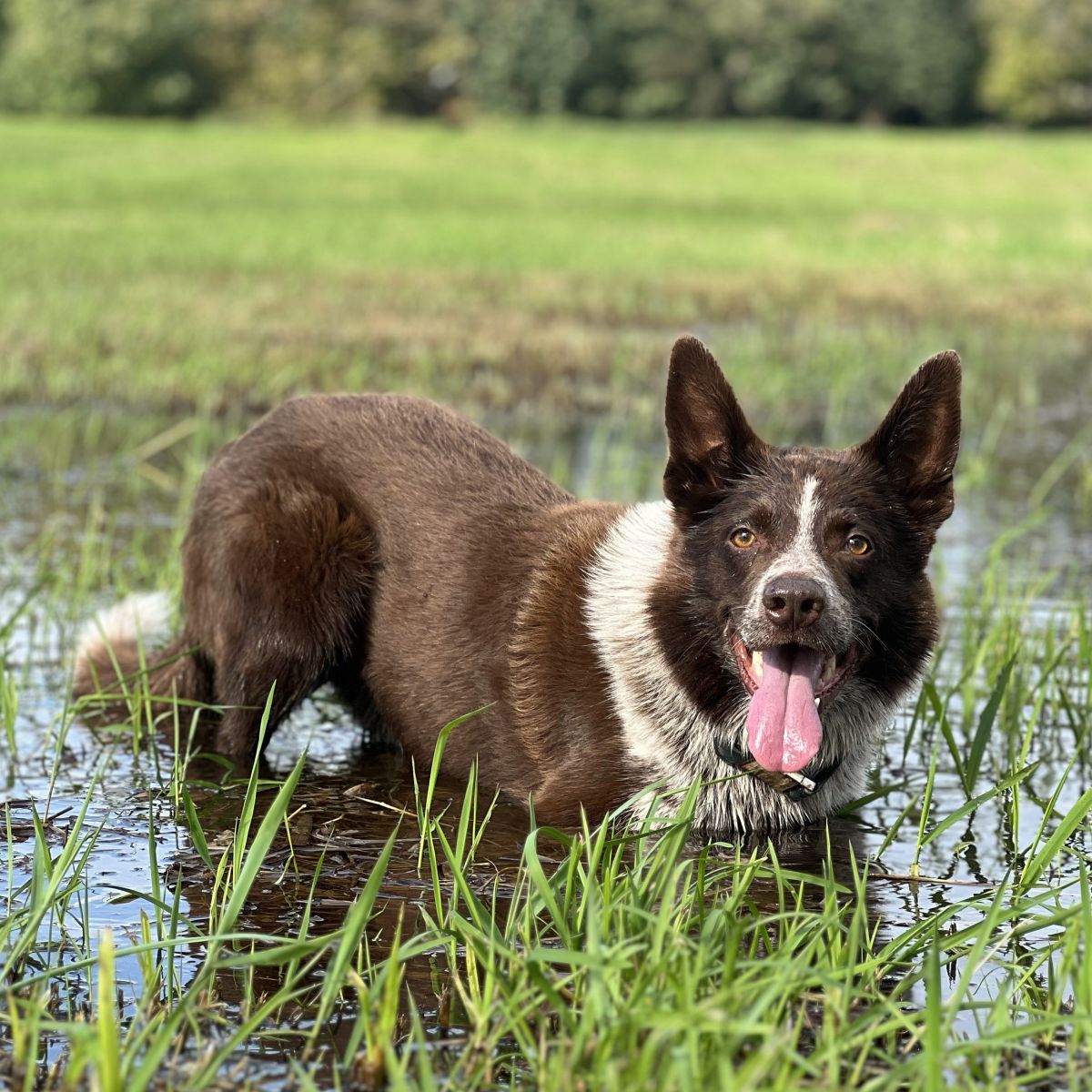
Hi! I’m Steffi. I am a biologist and a big time dog nerd. You are curious about coat color genetics? You’ve come to the right place! Read more.


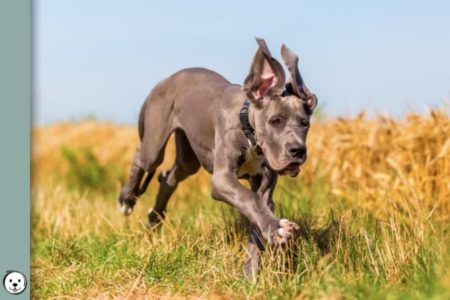
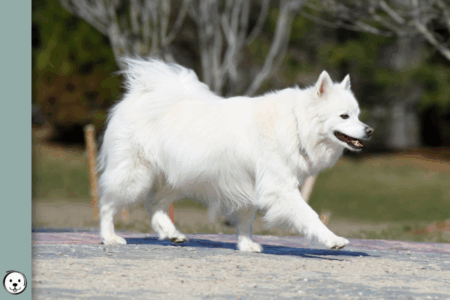

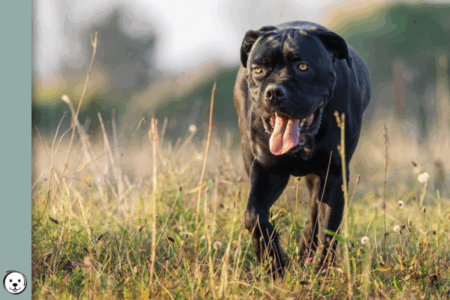
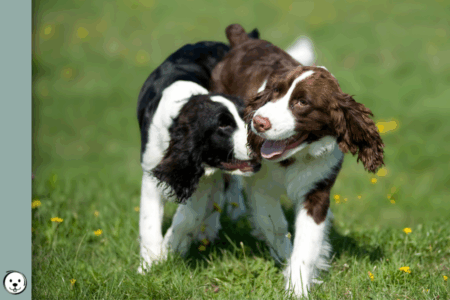
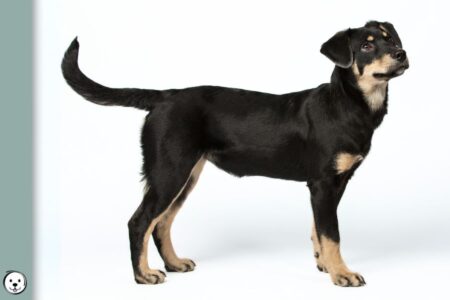
2 thoughts on “Beagle Coat Colors”
Comments are closed.